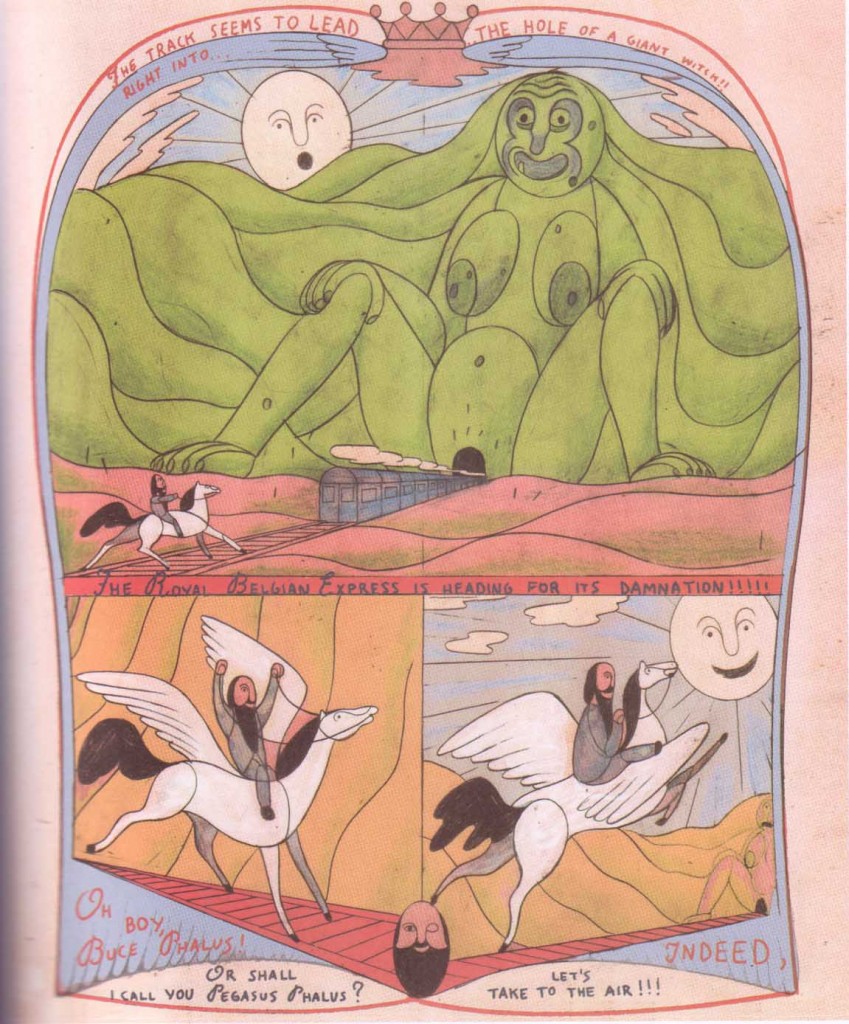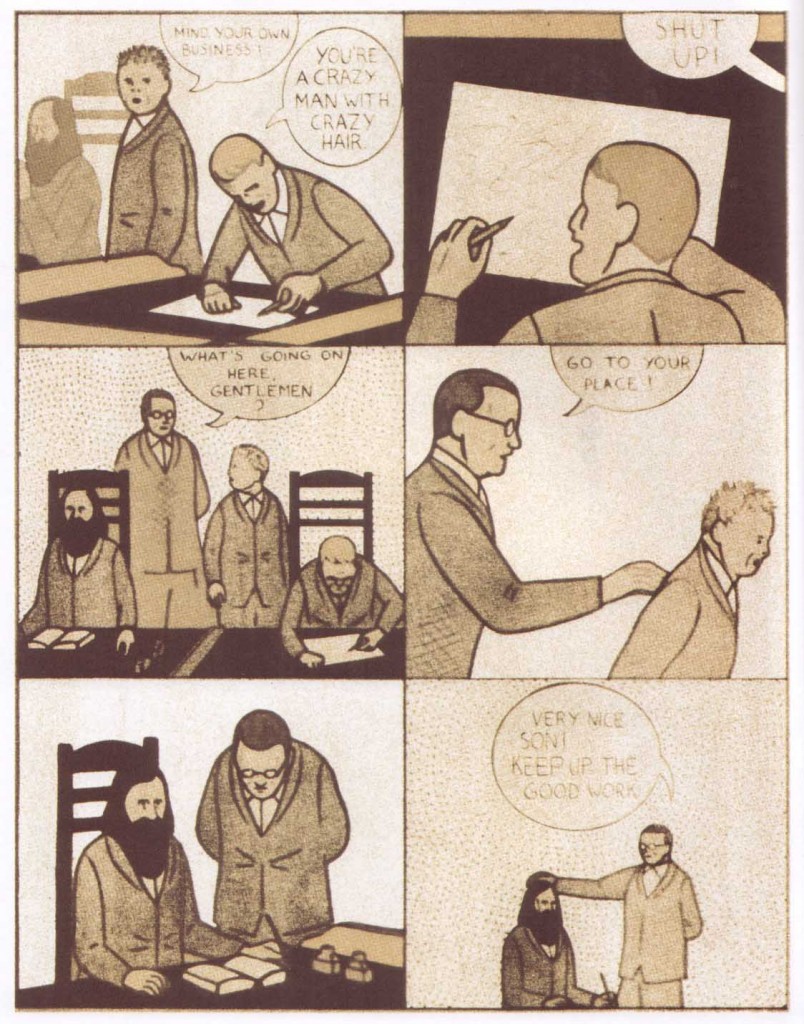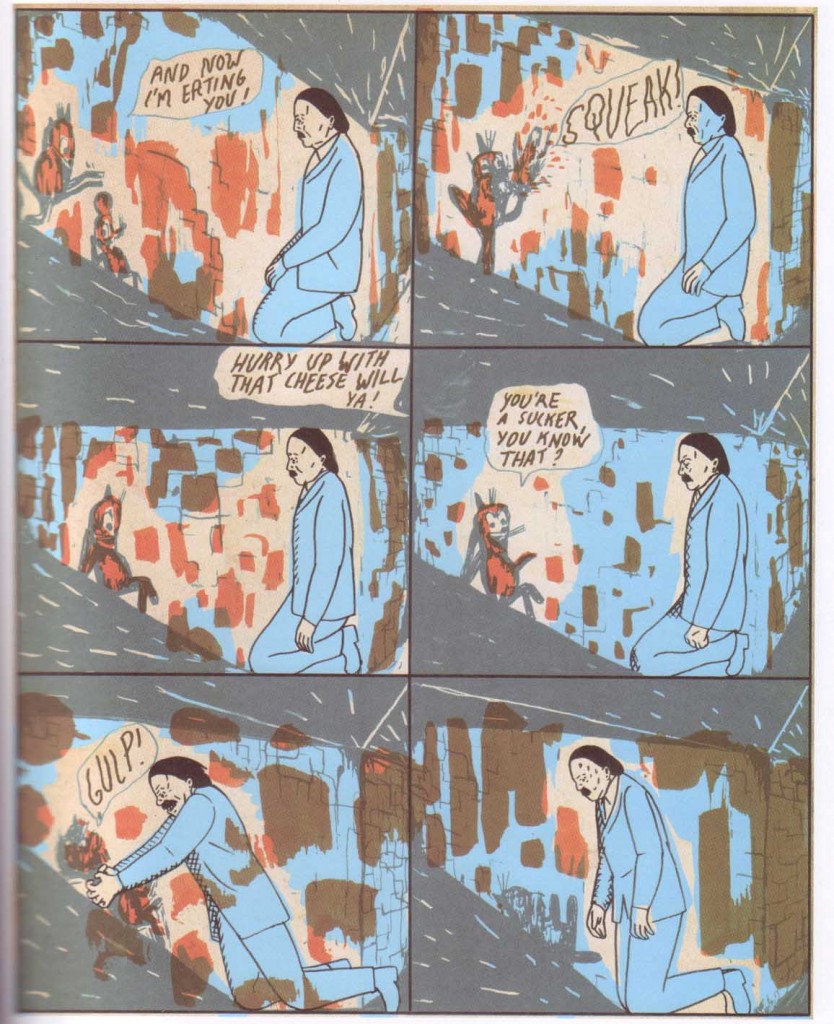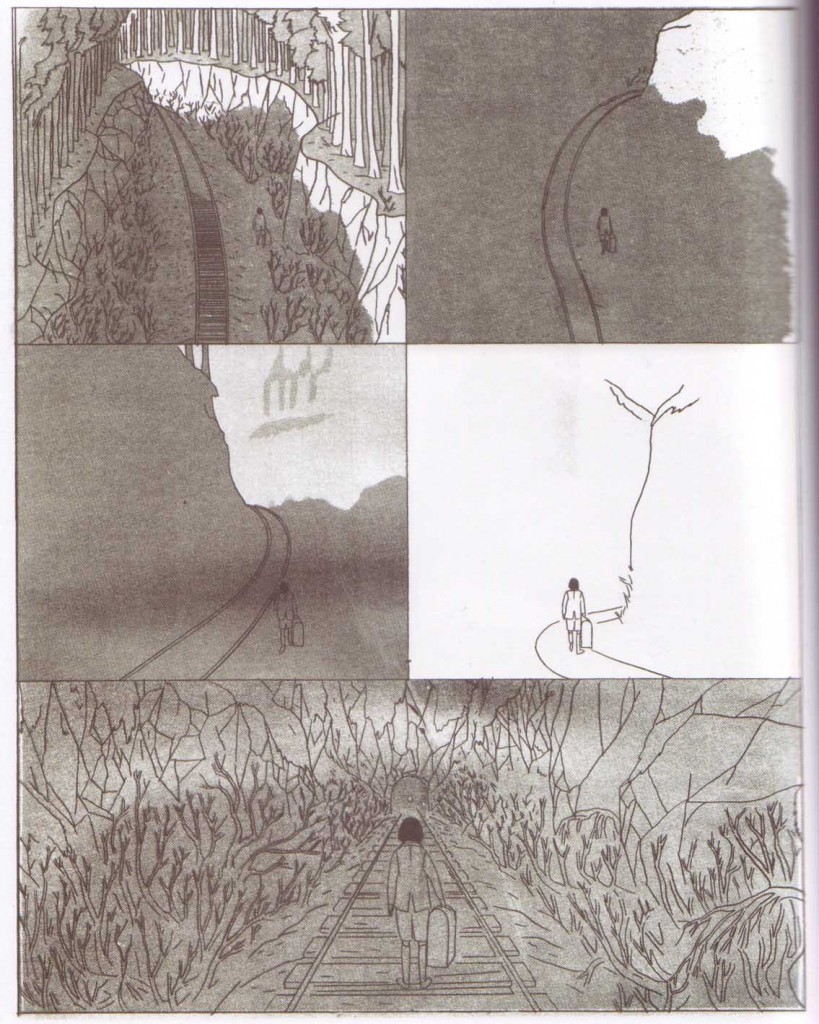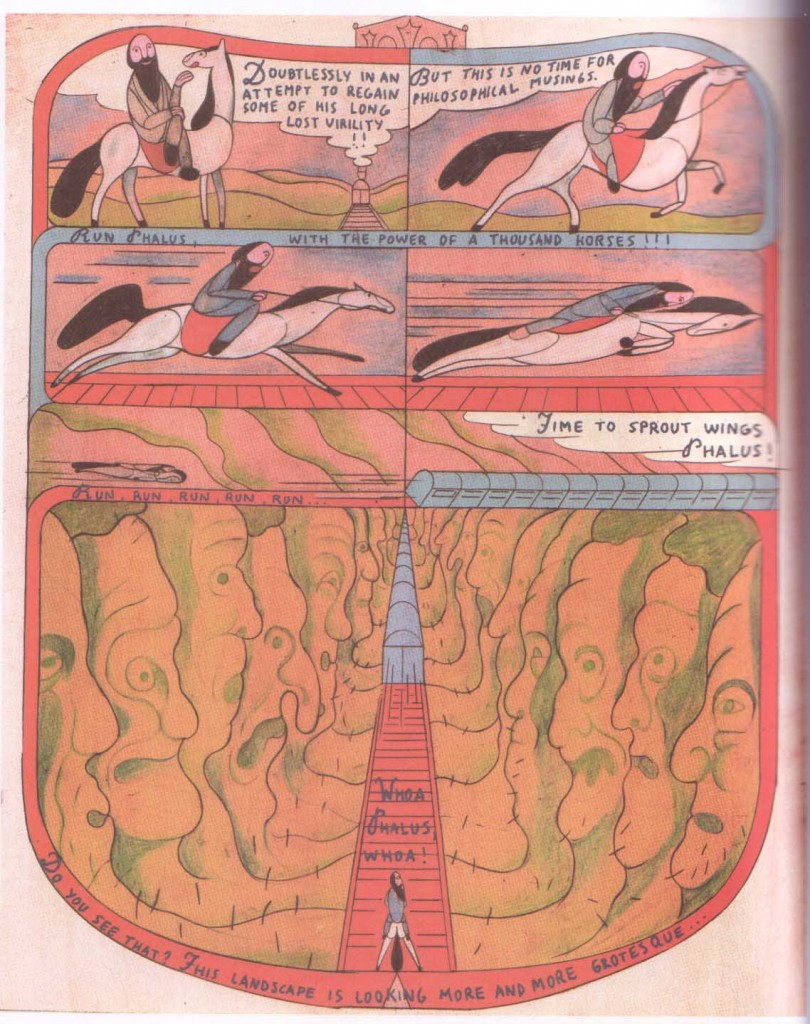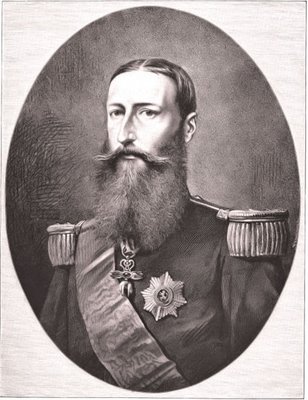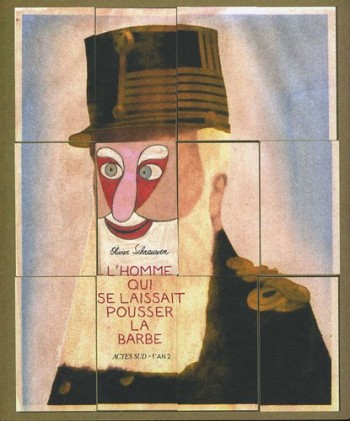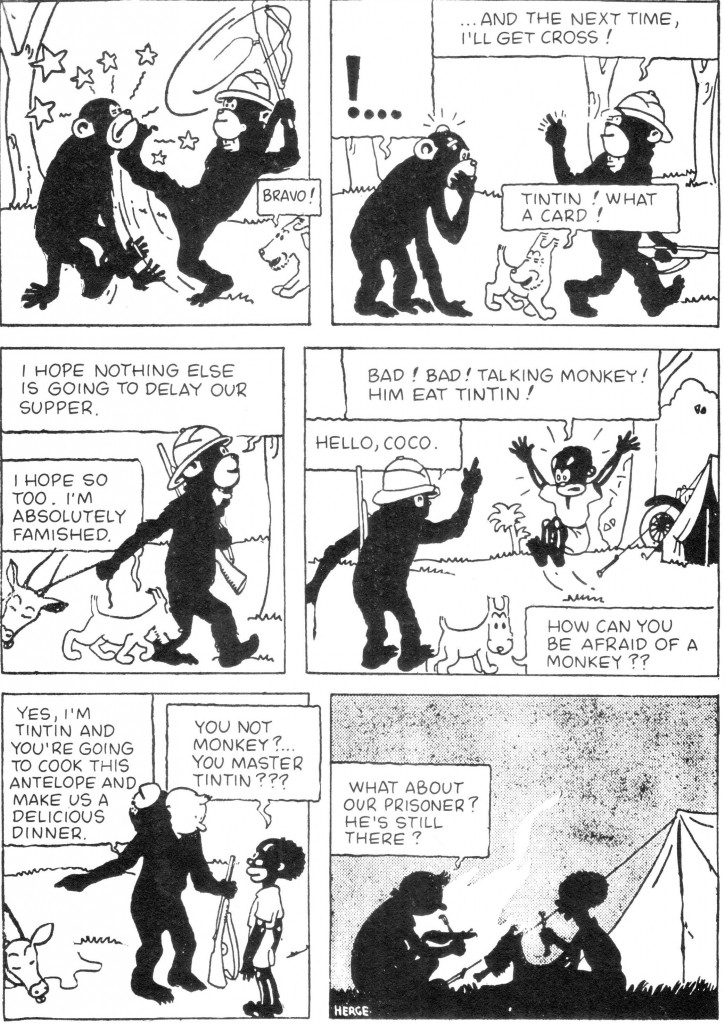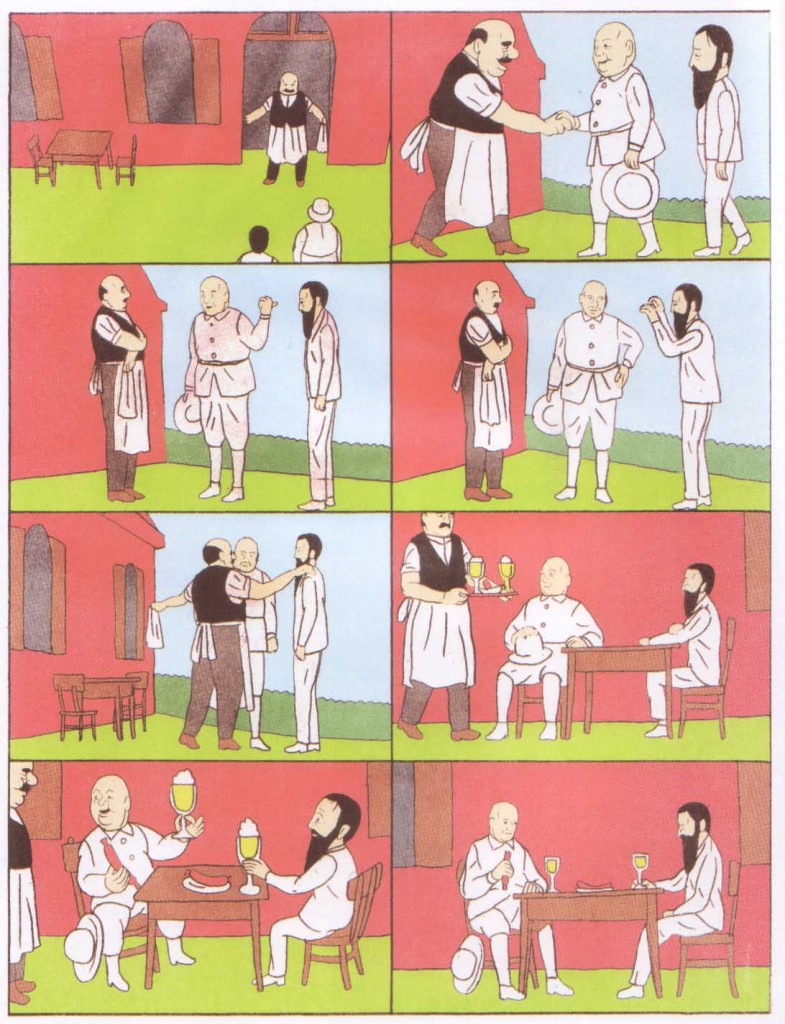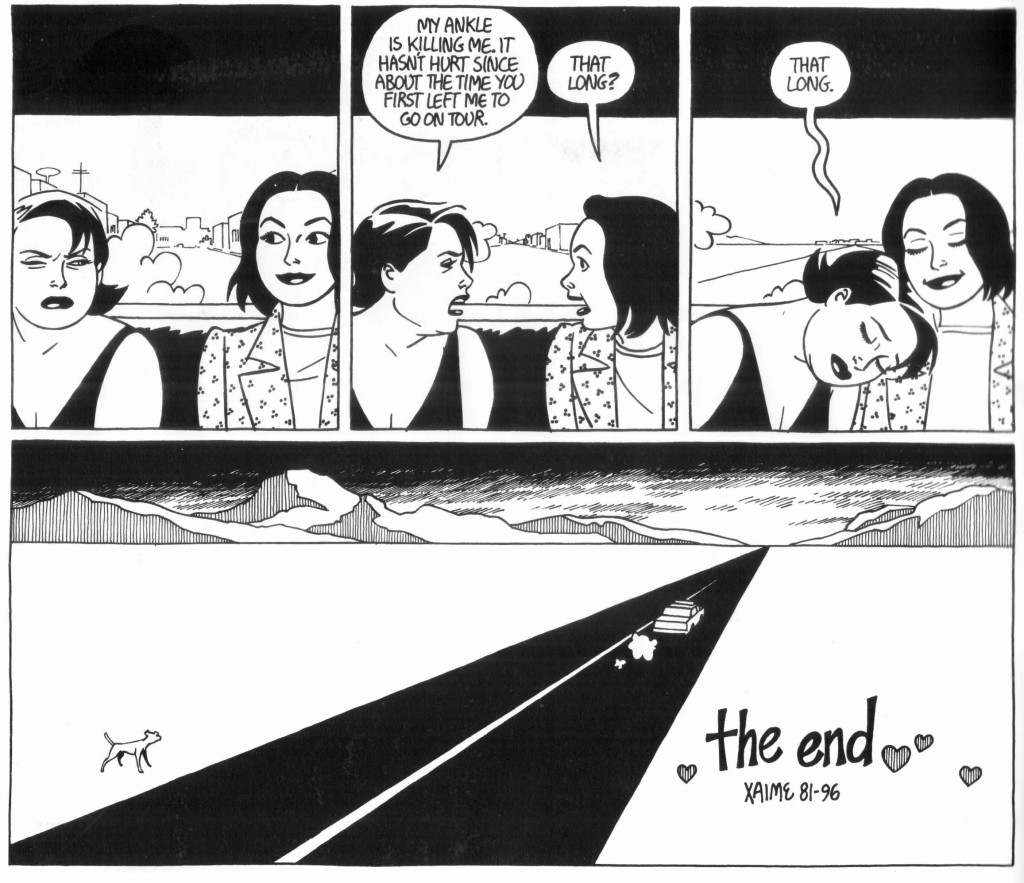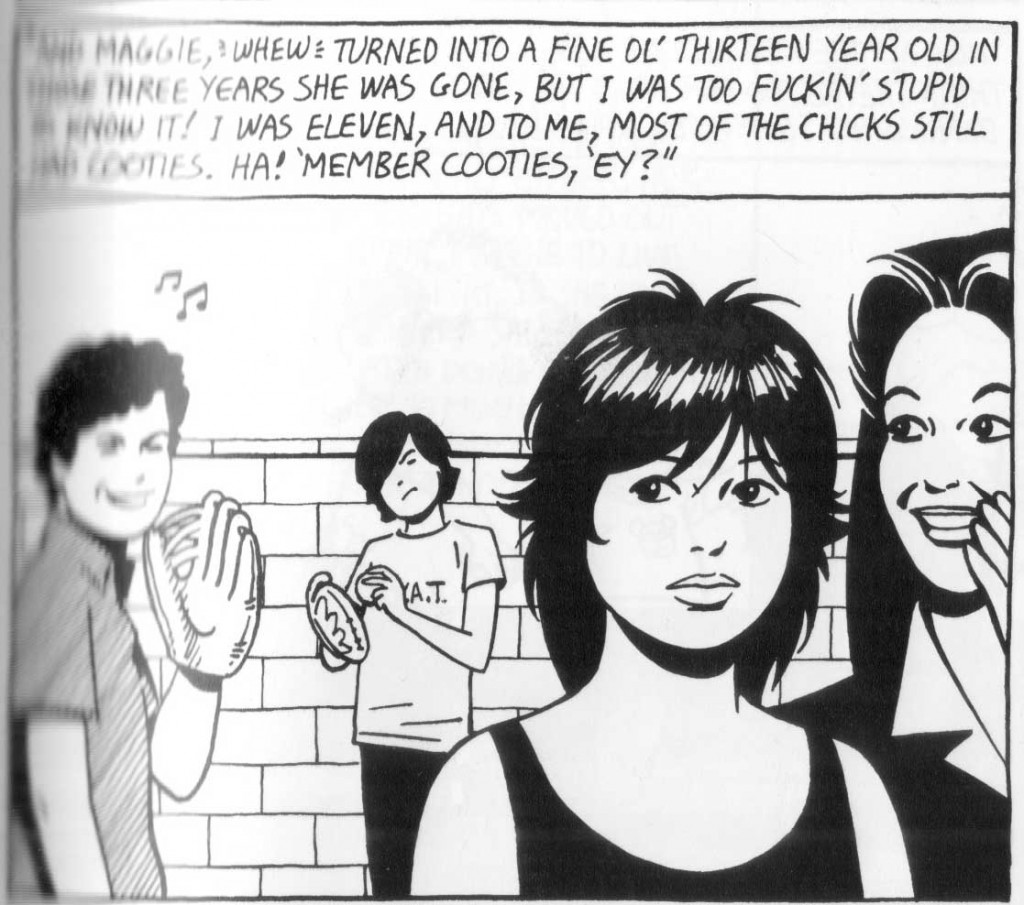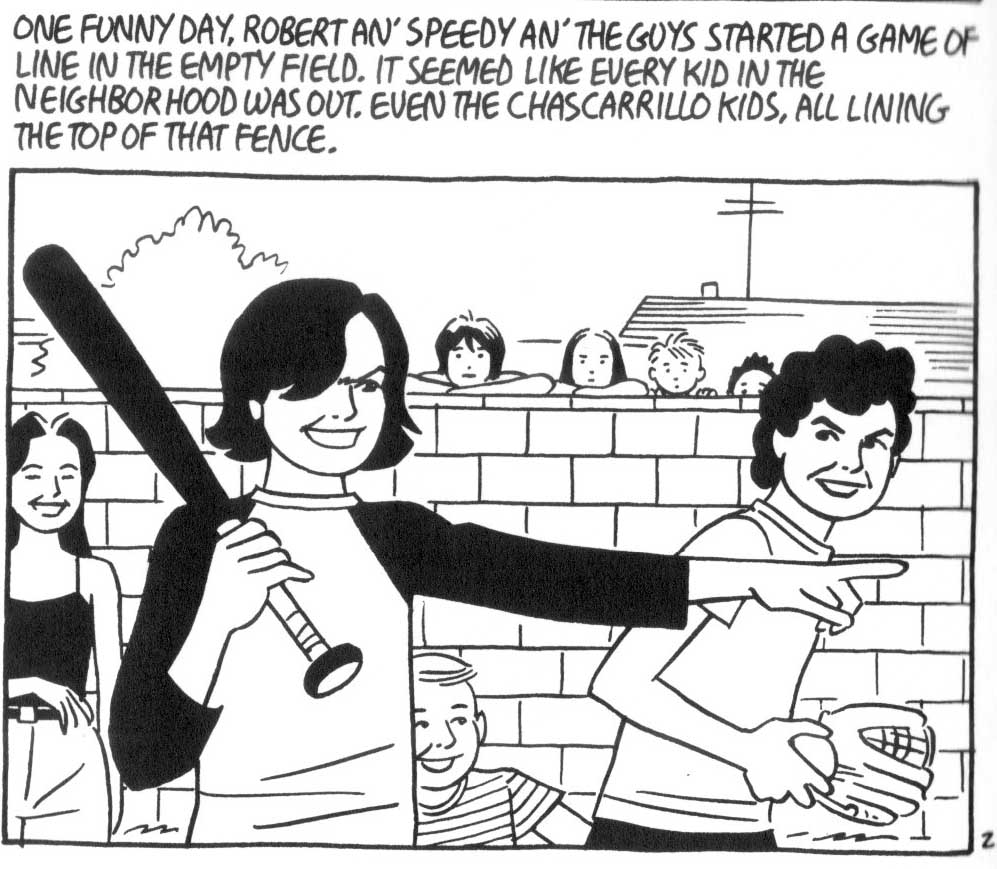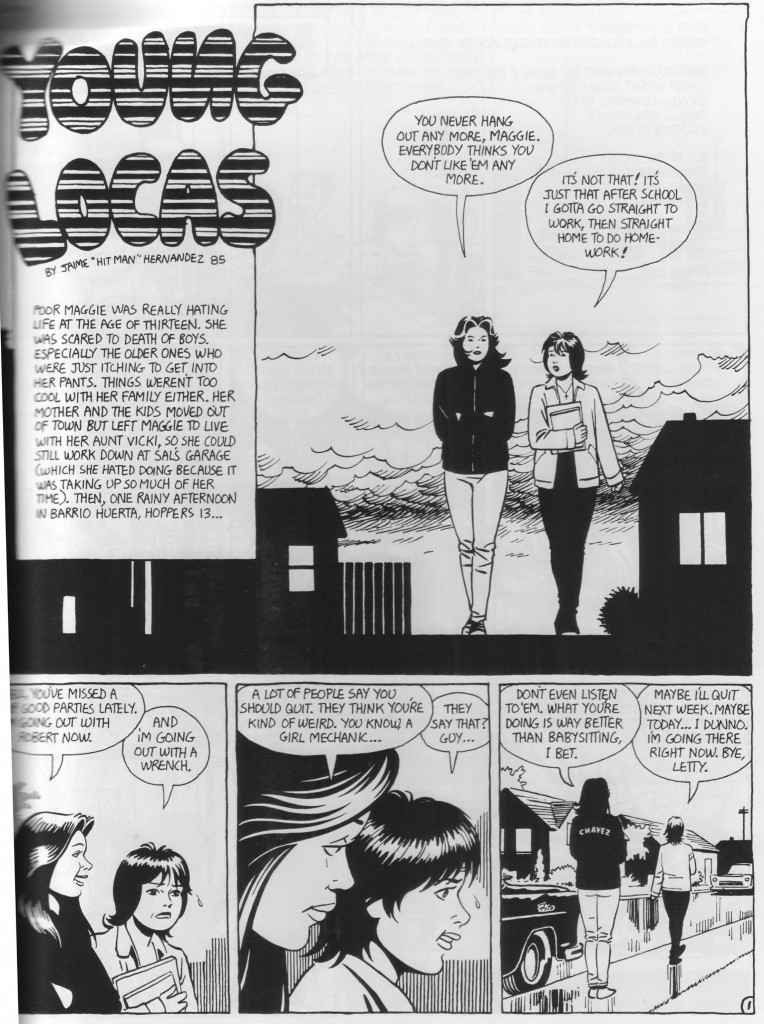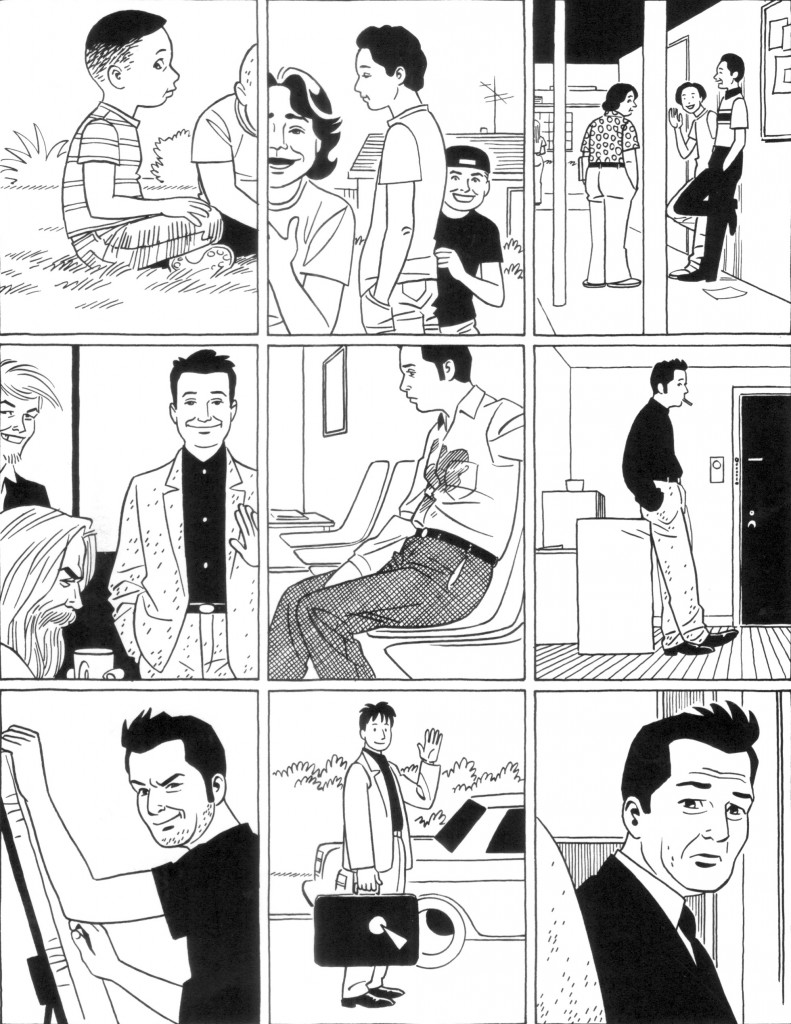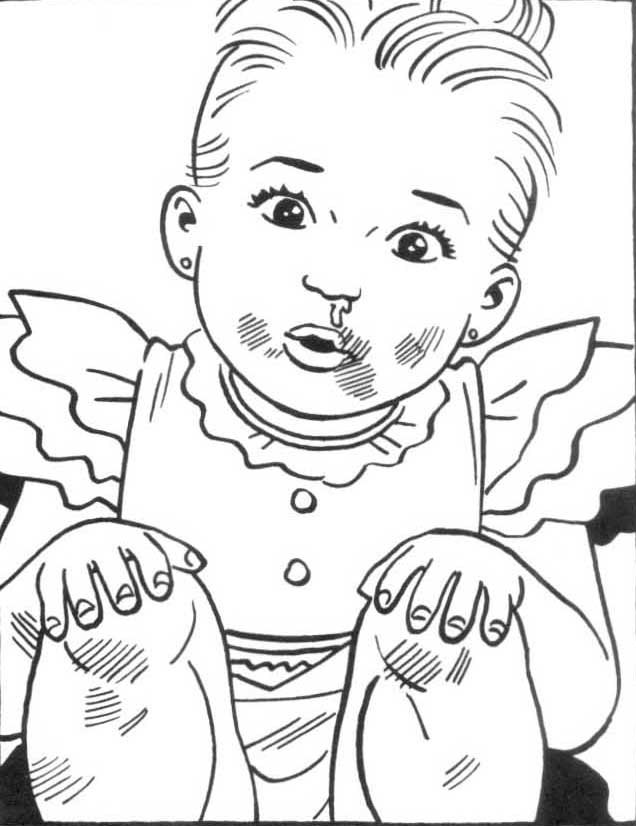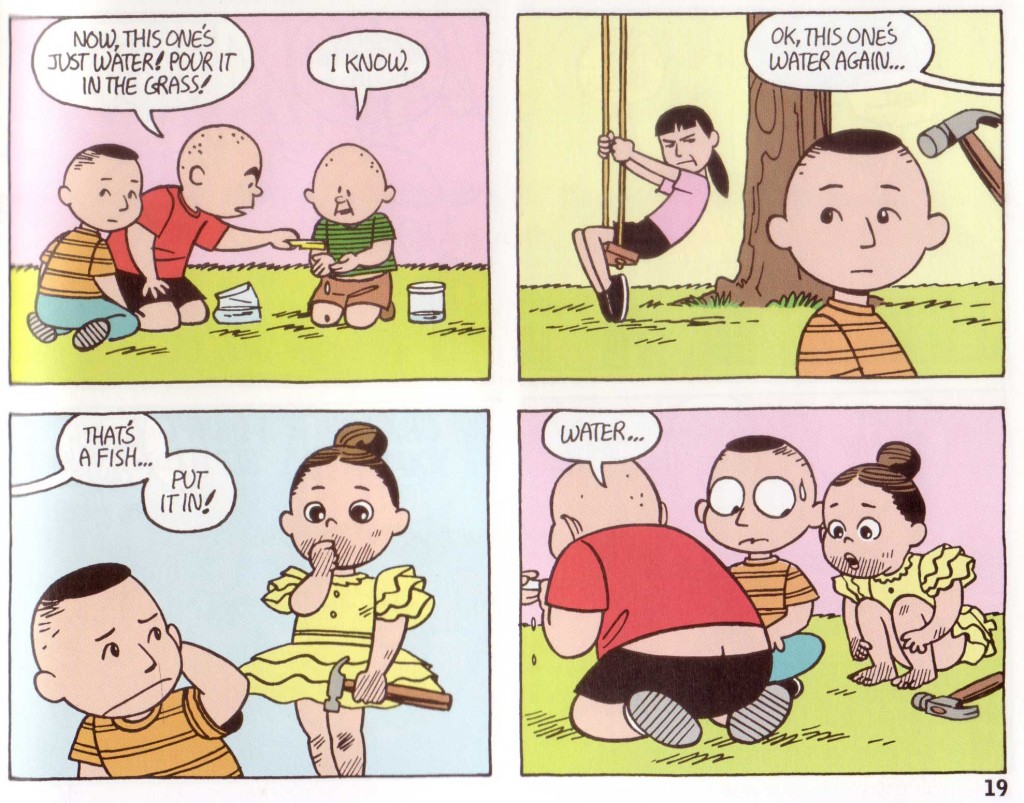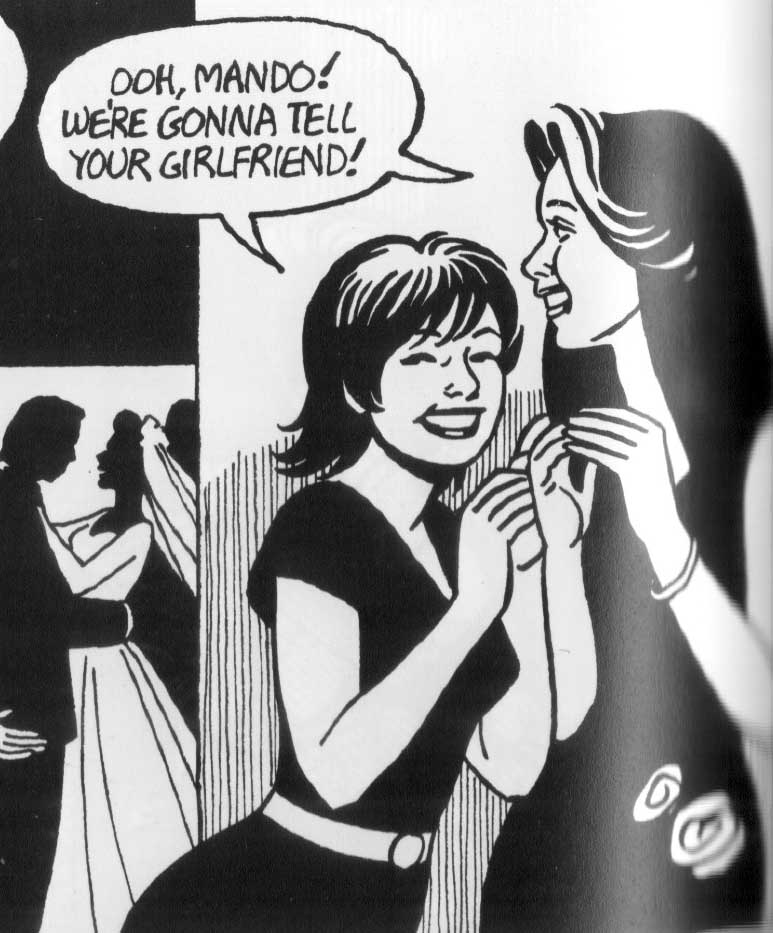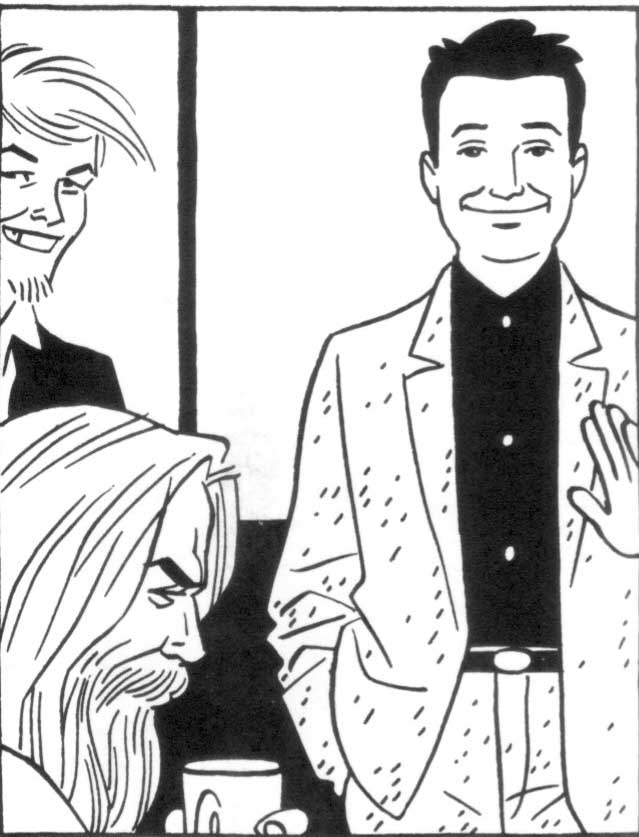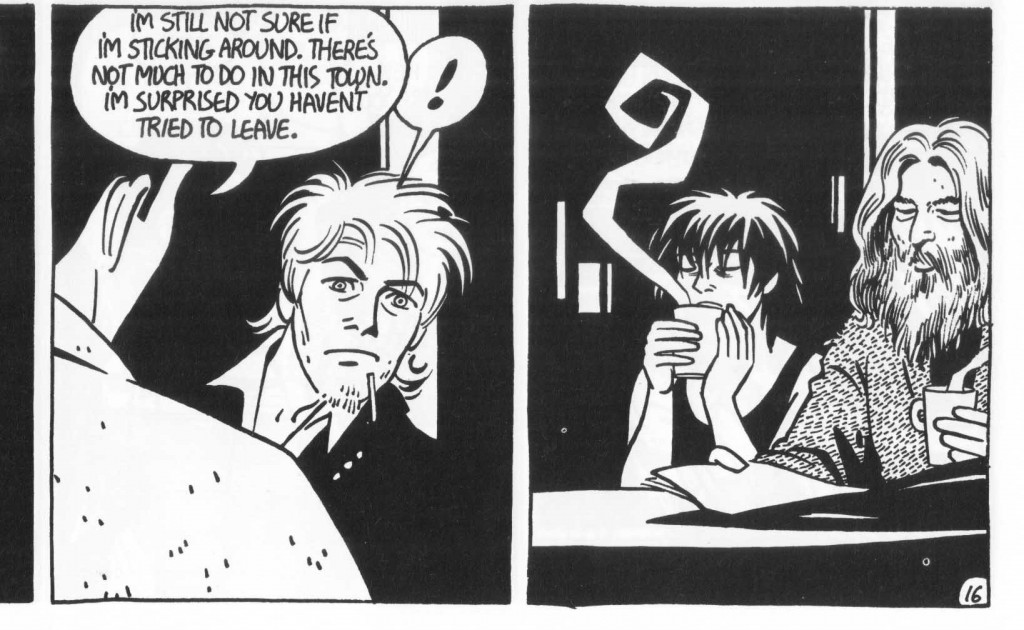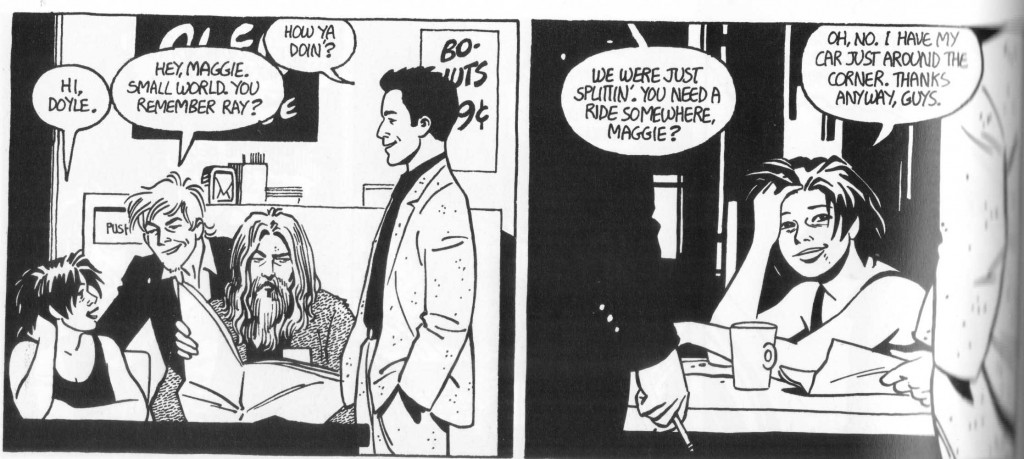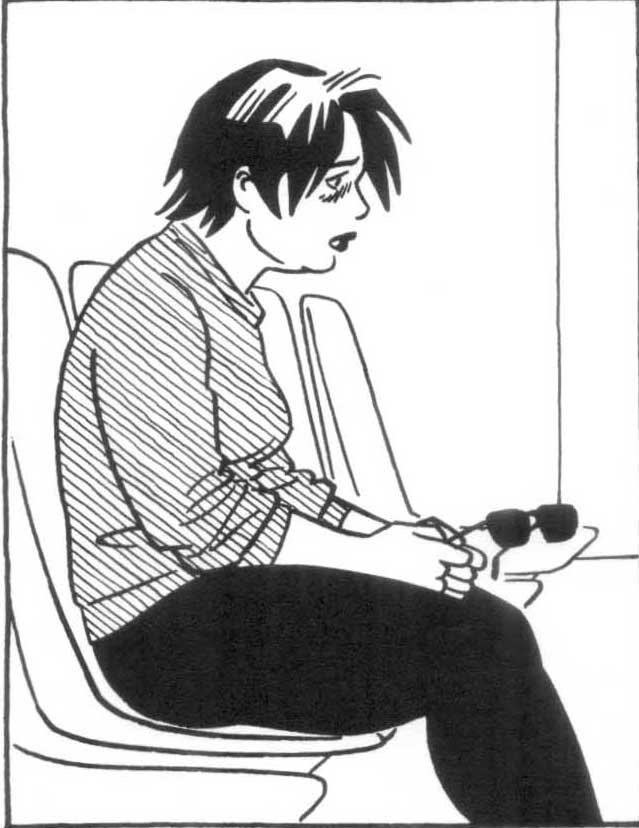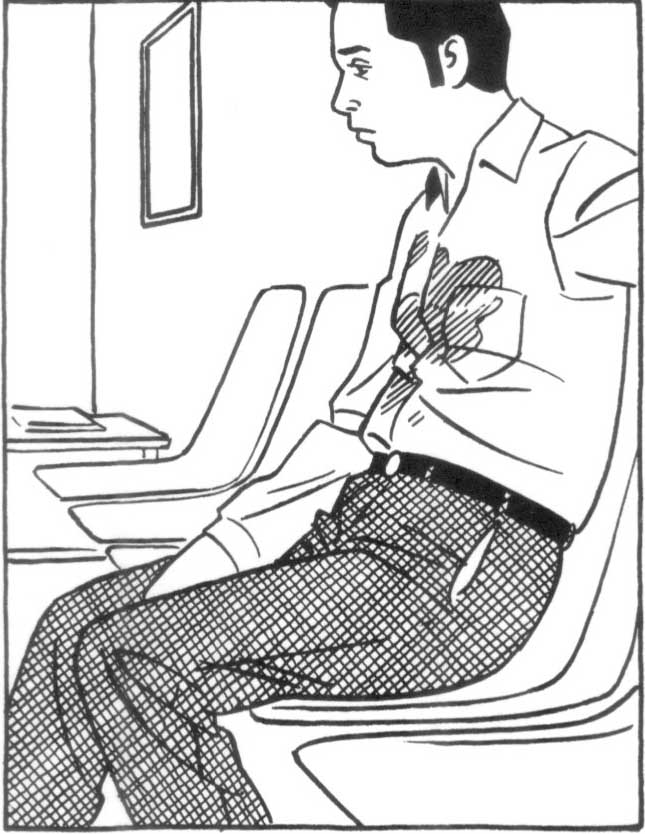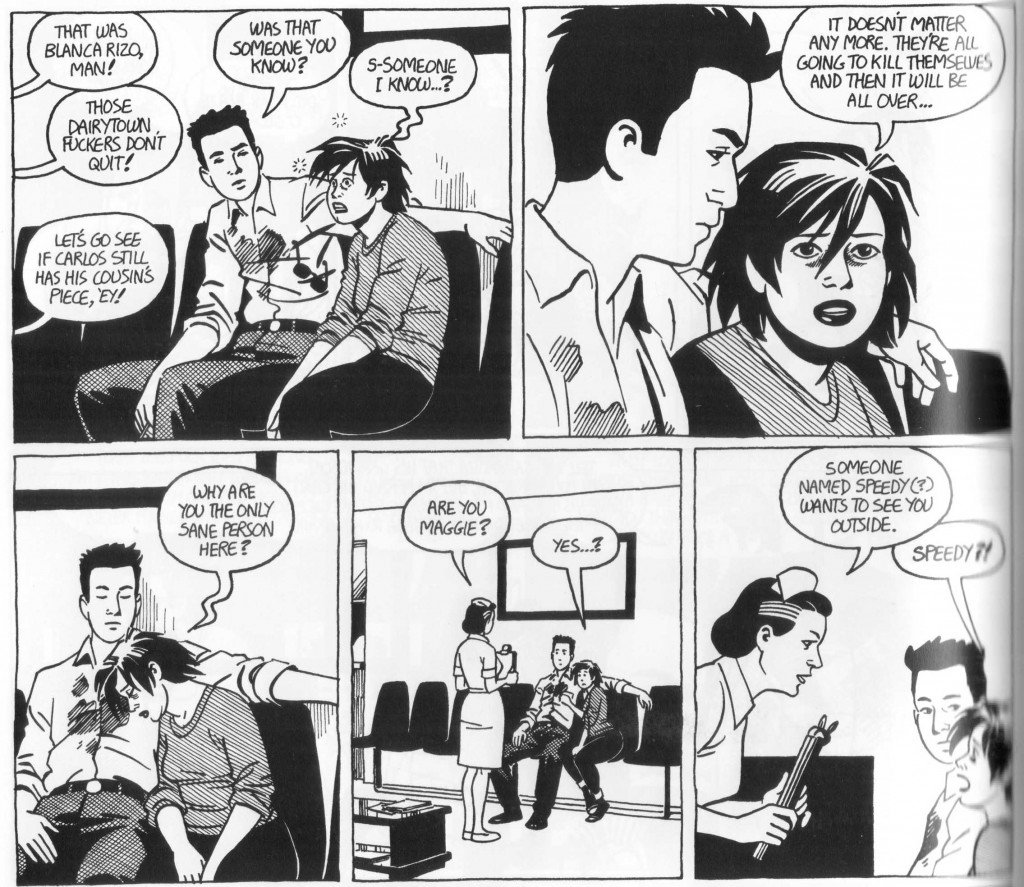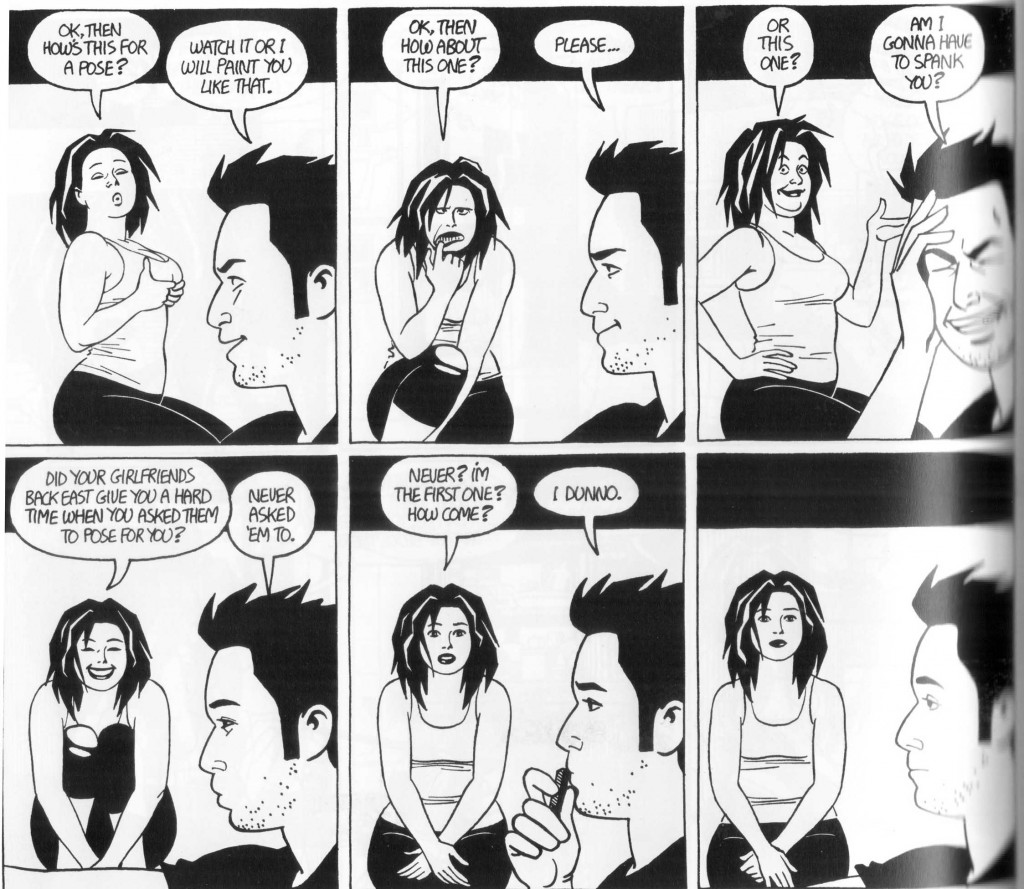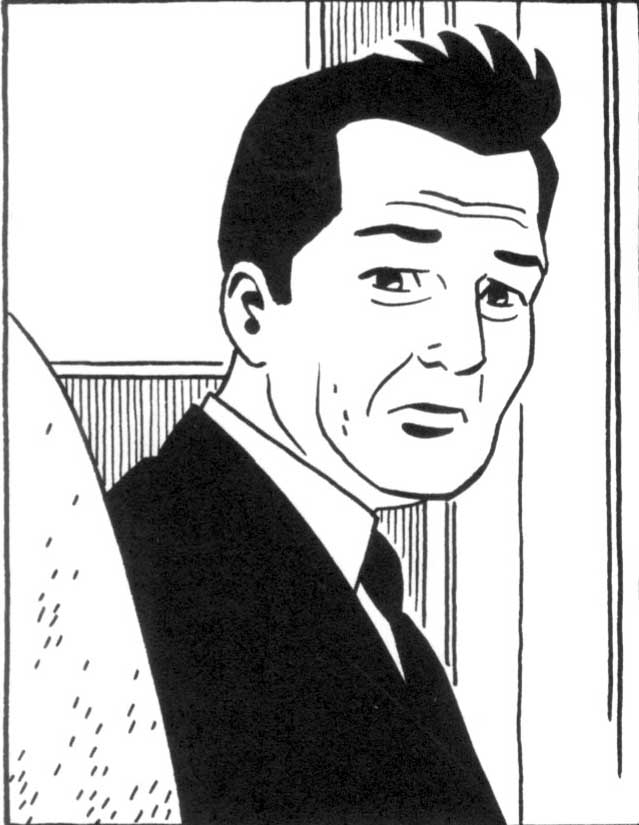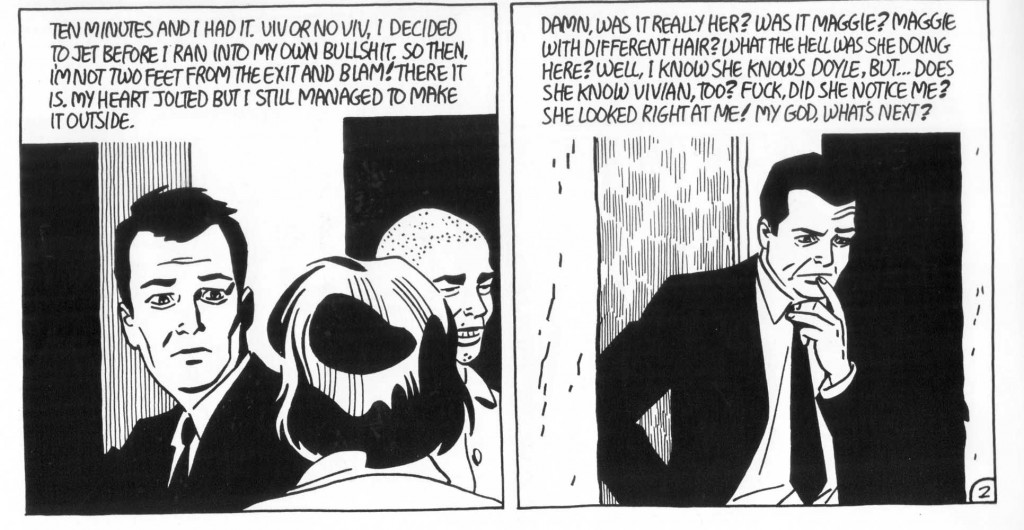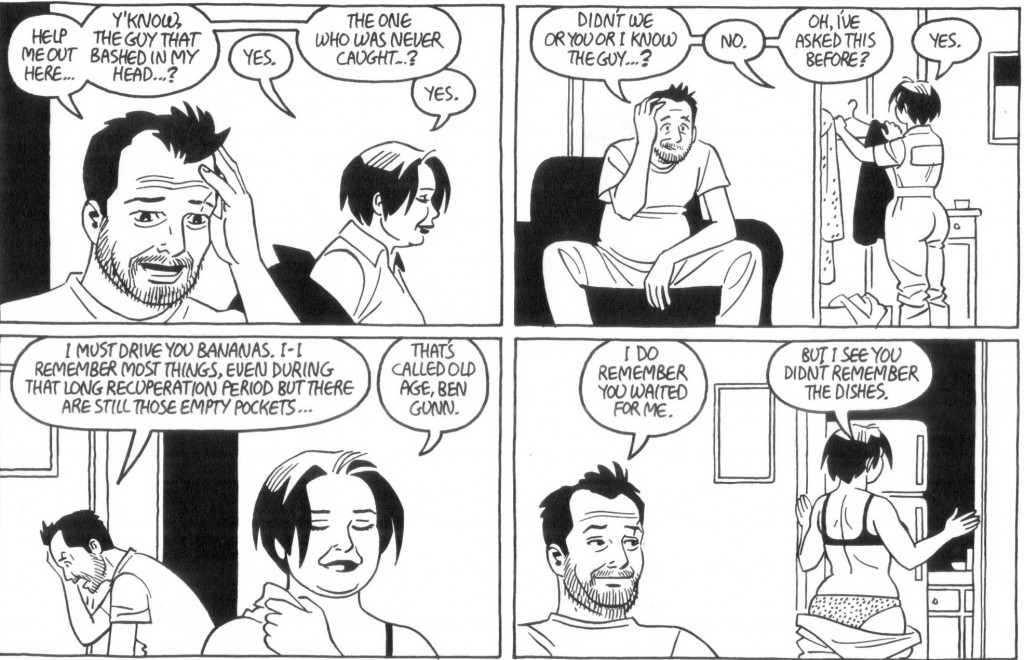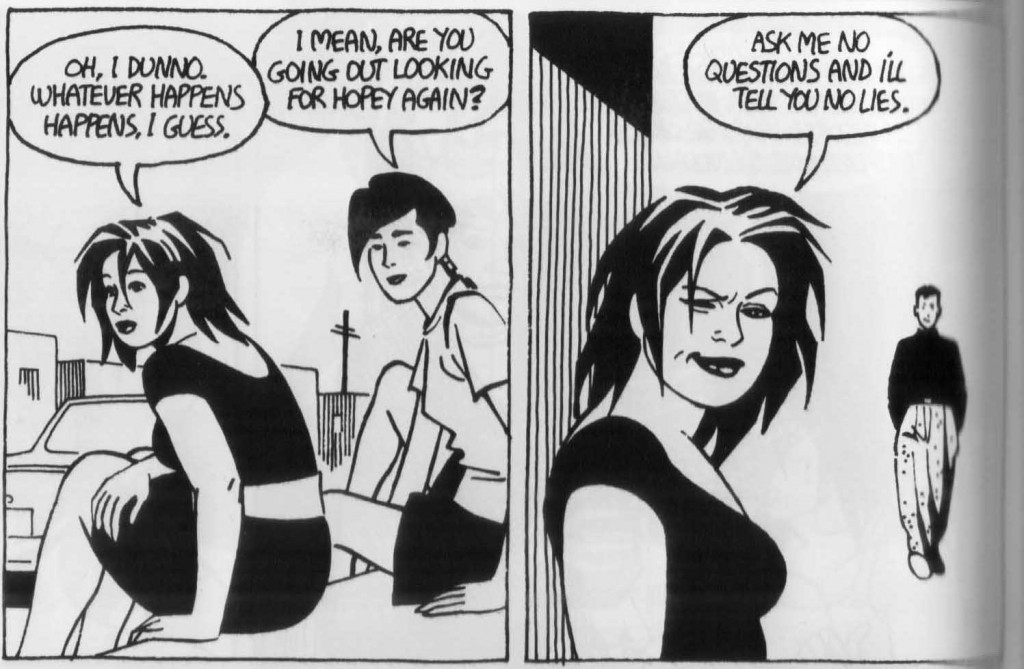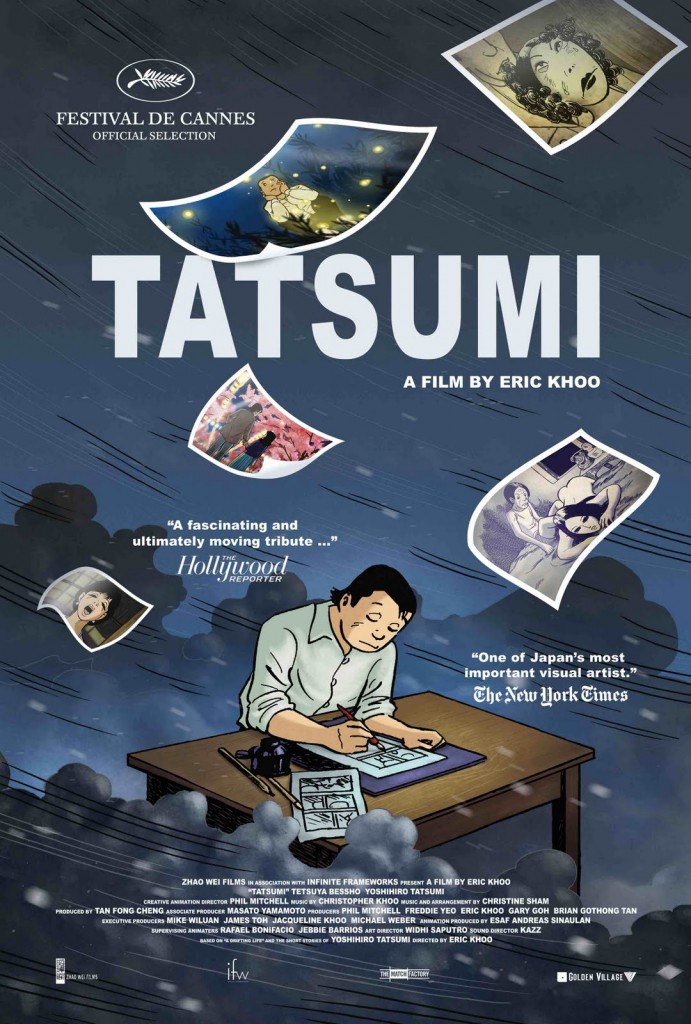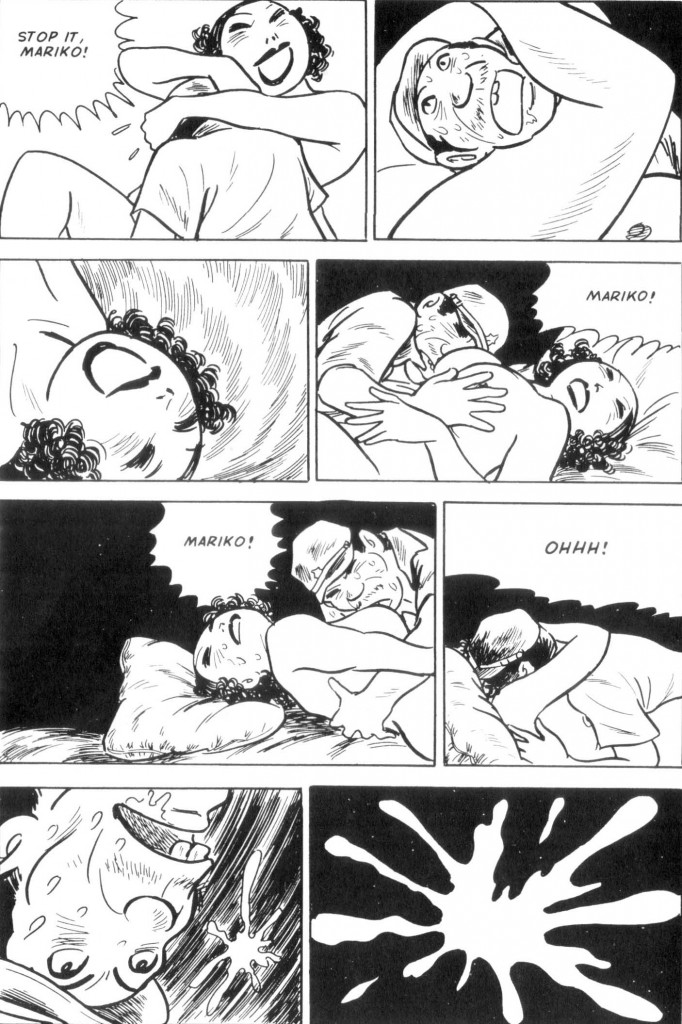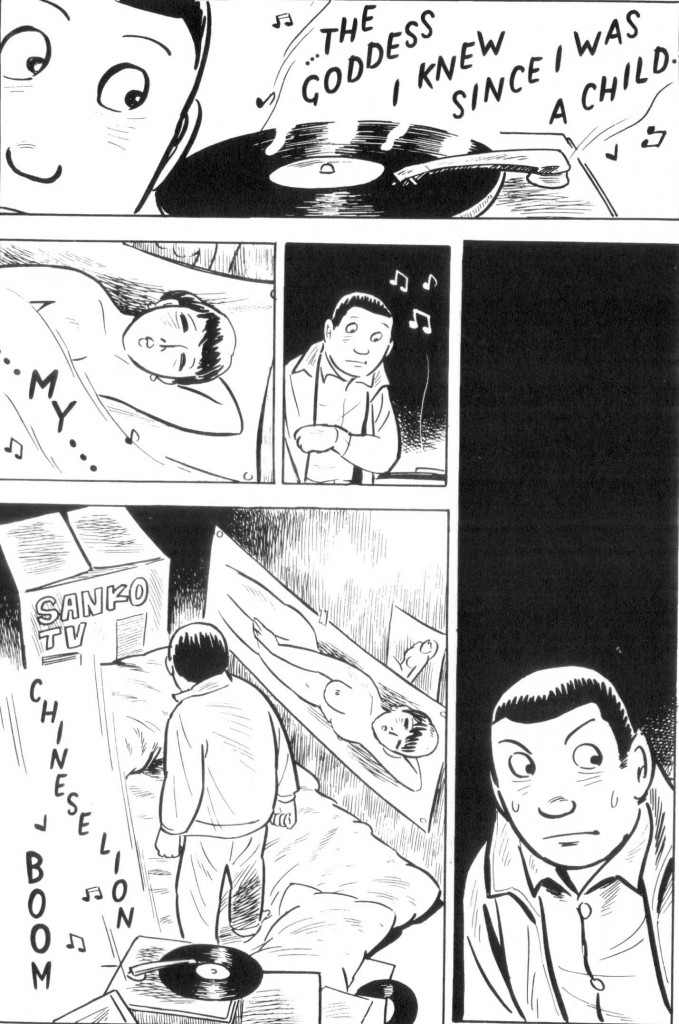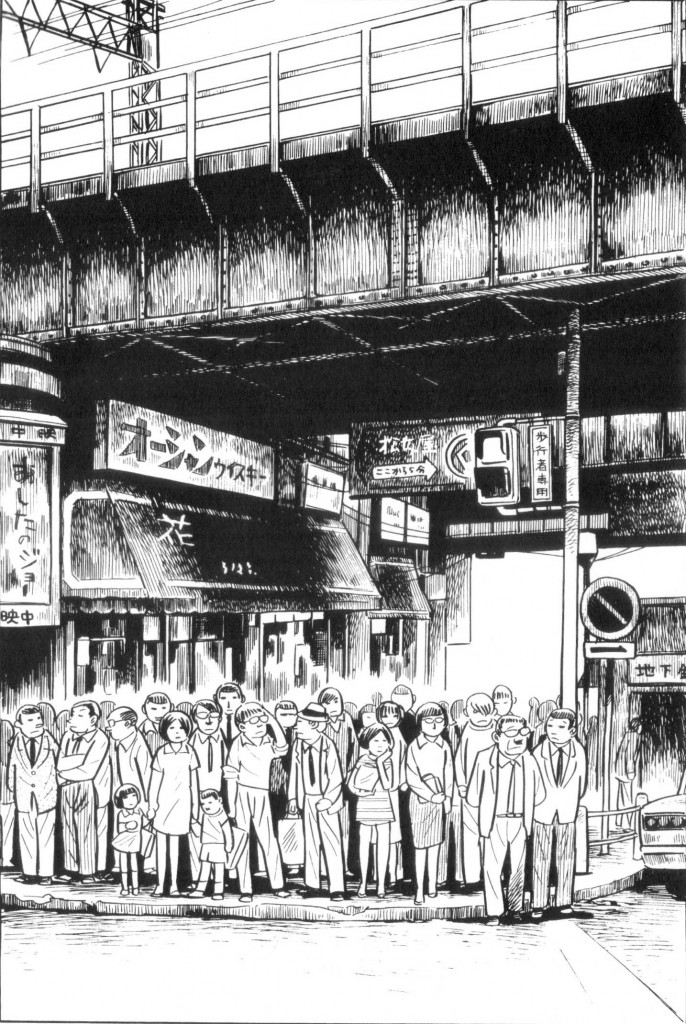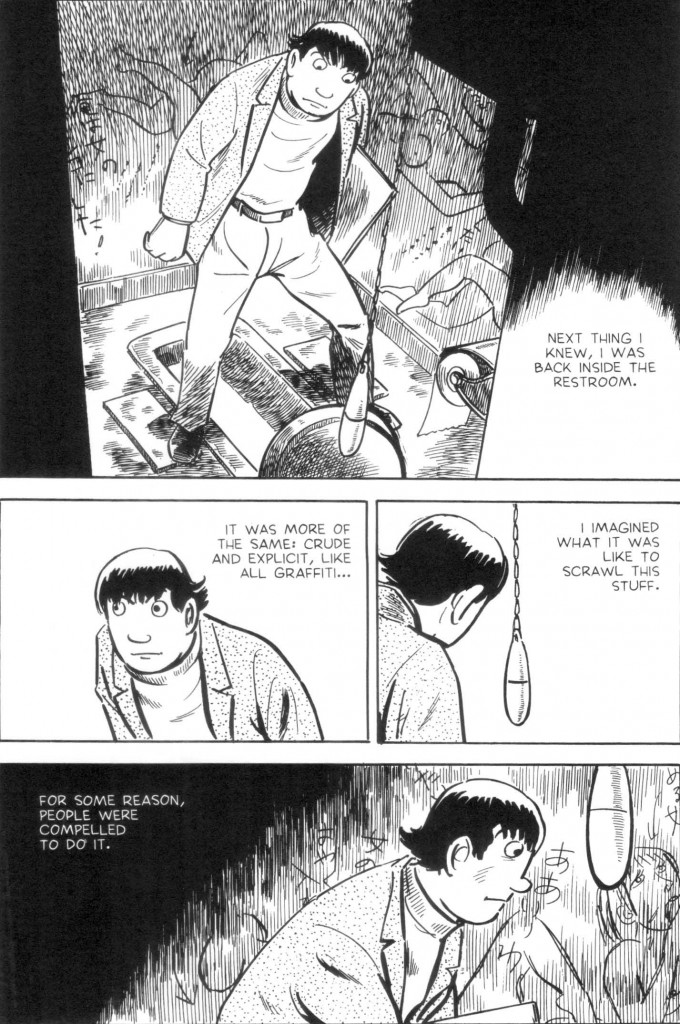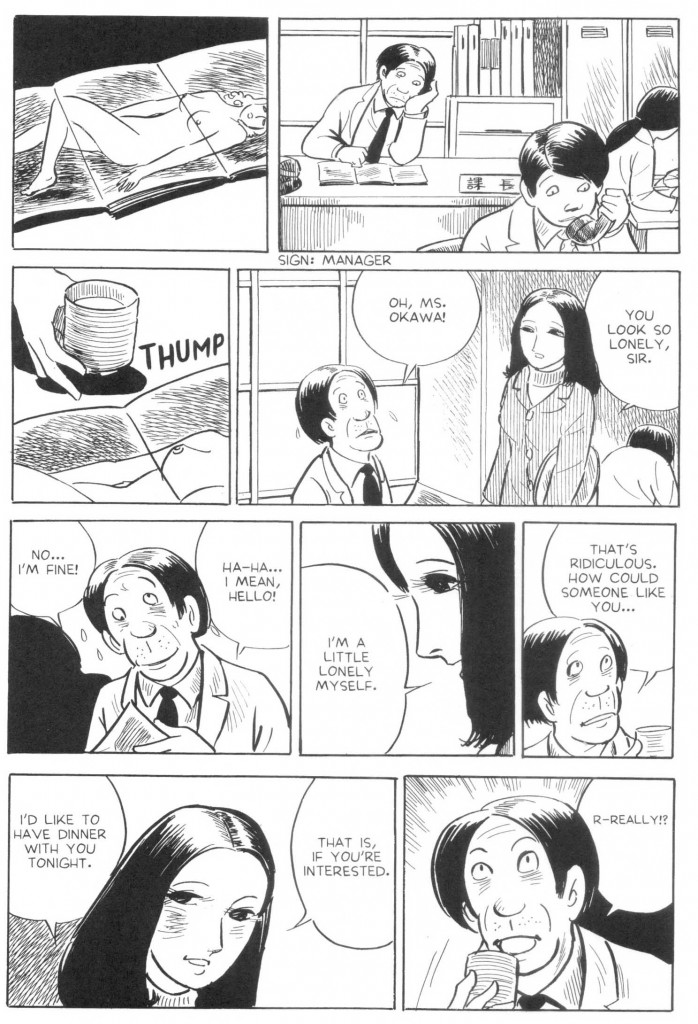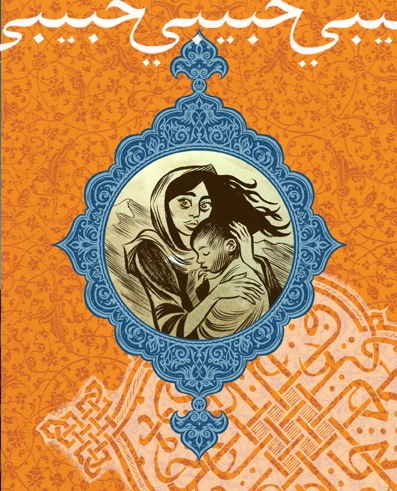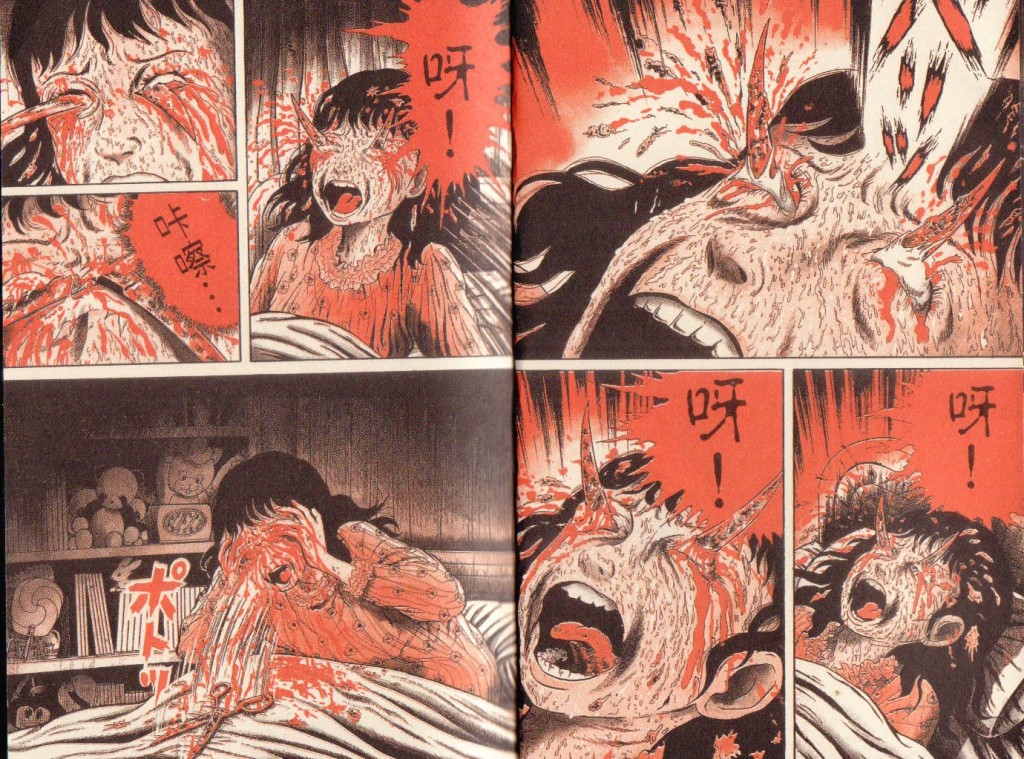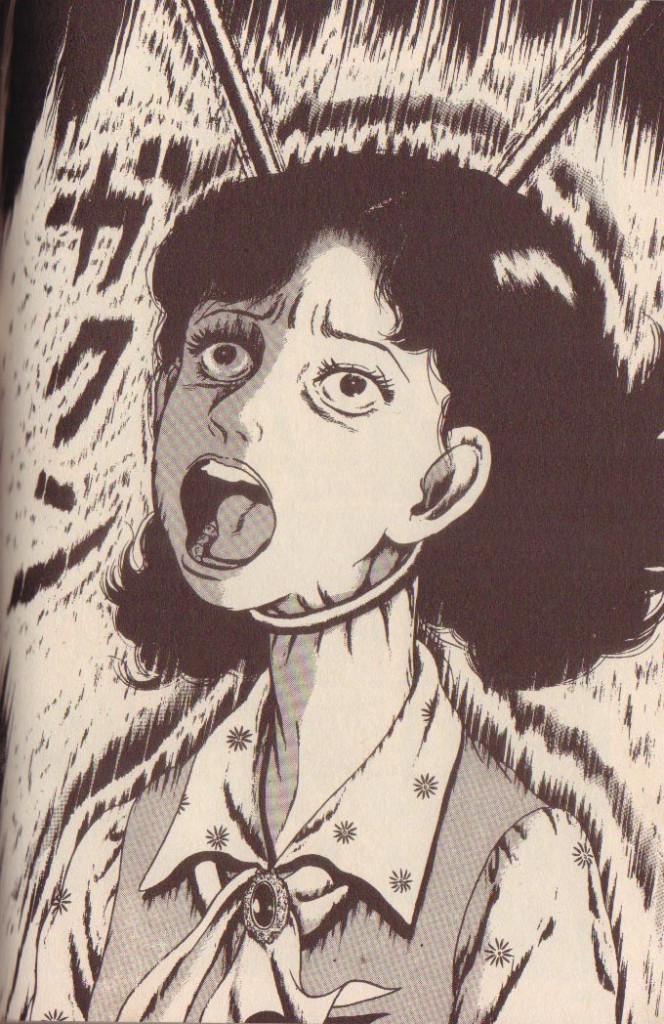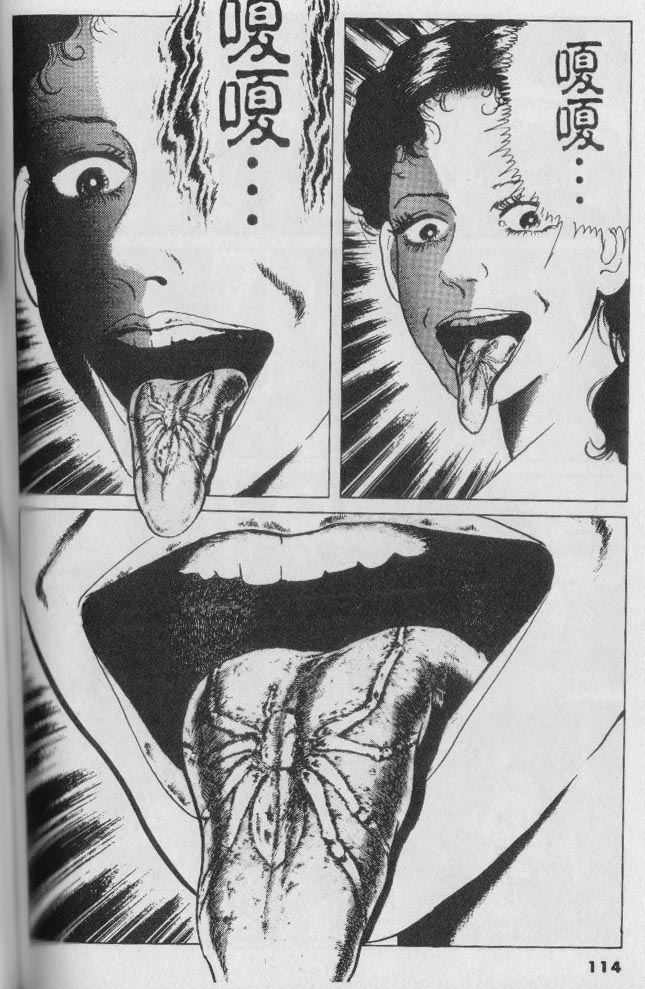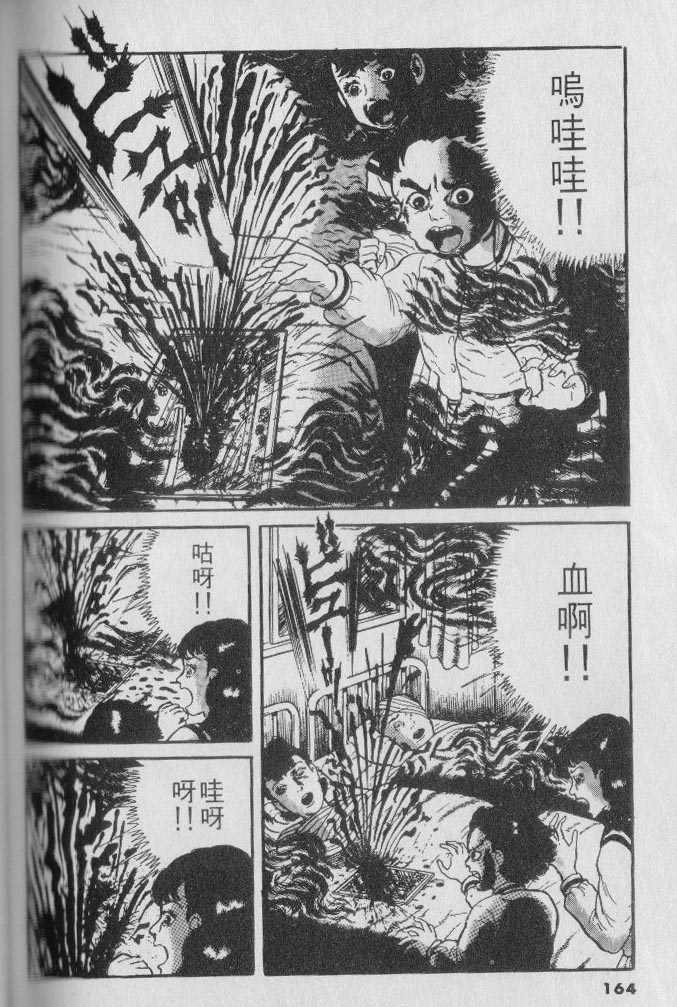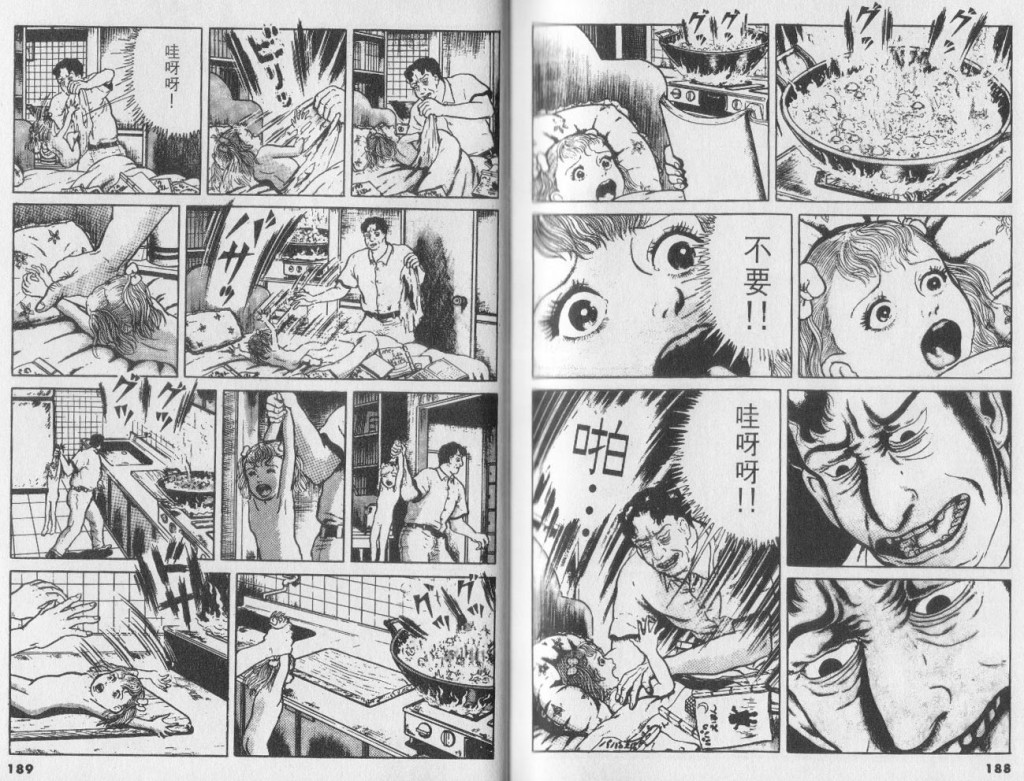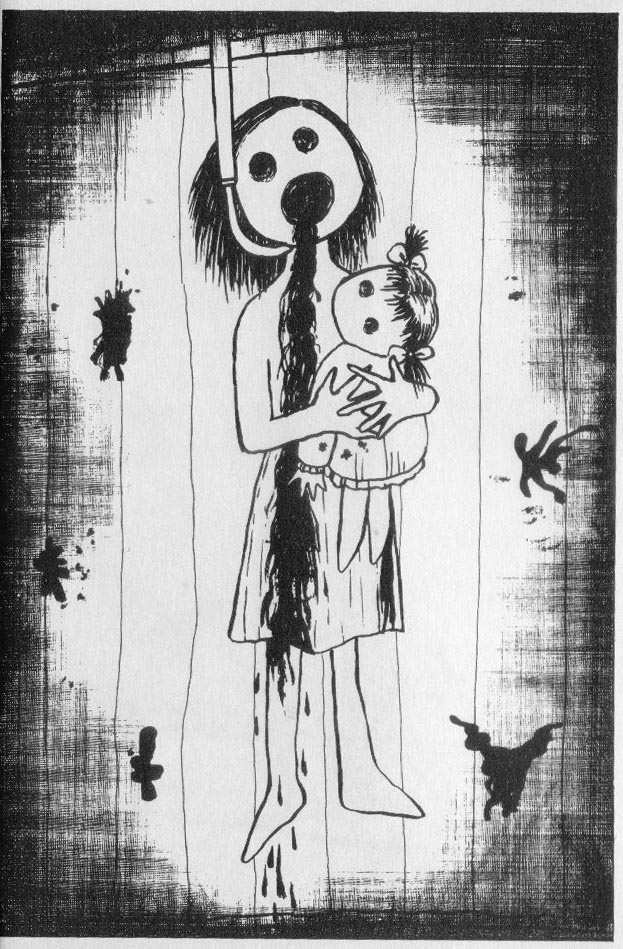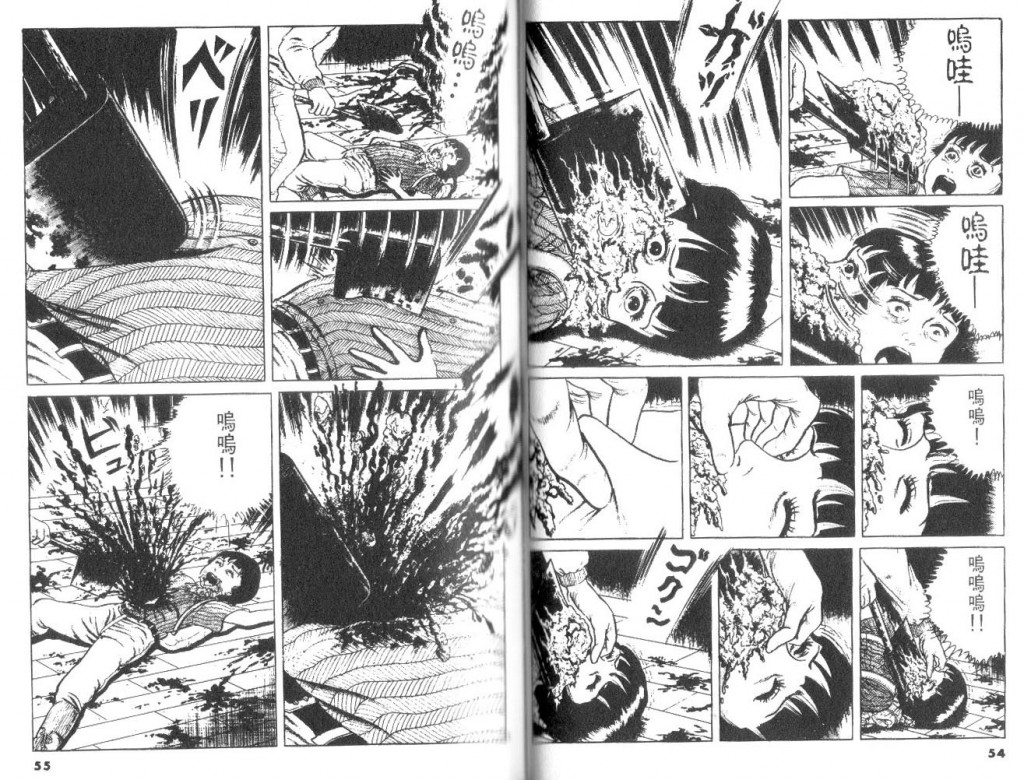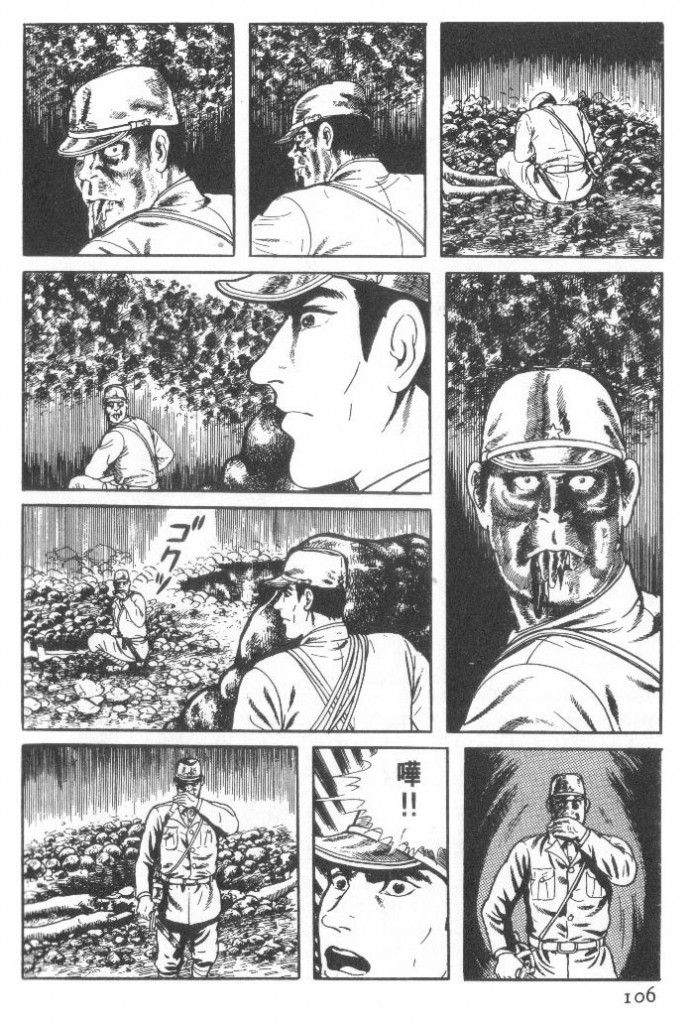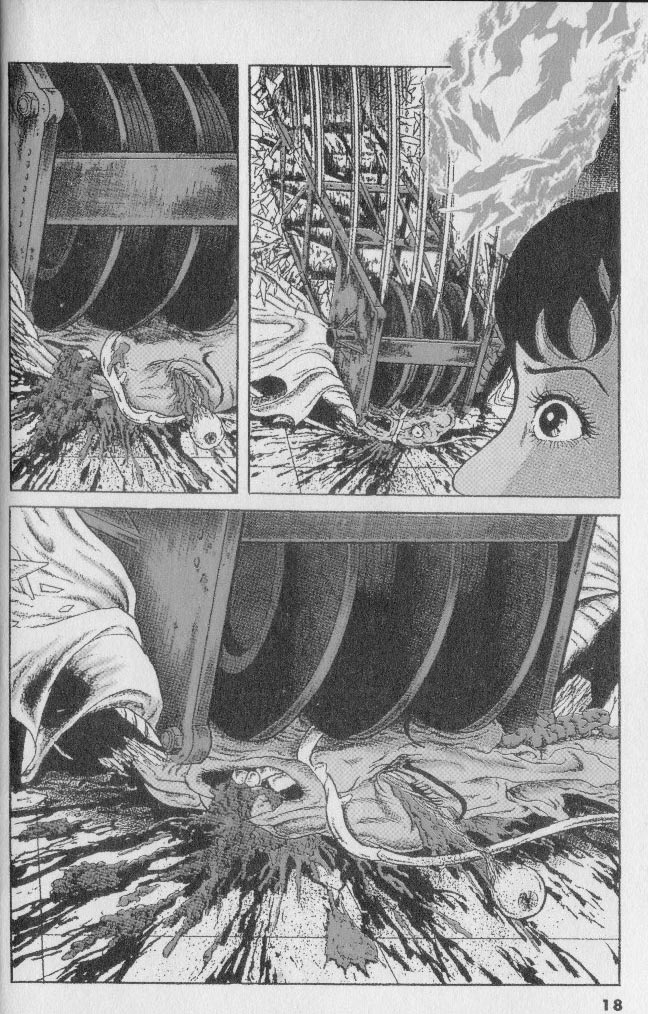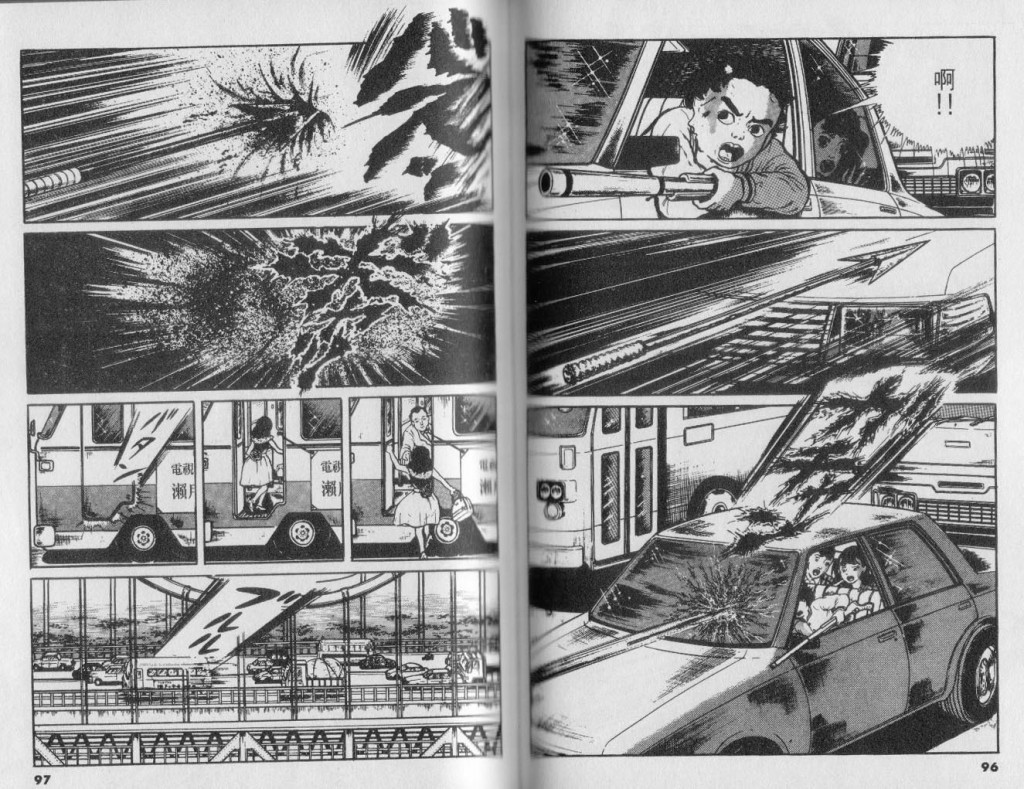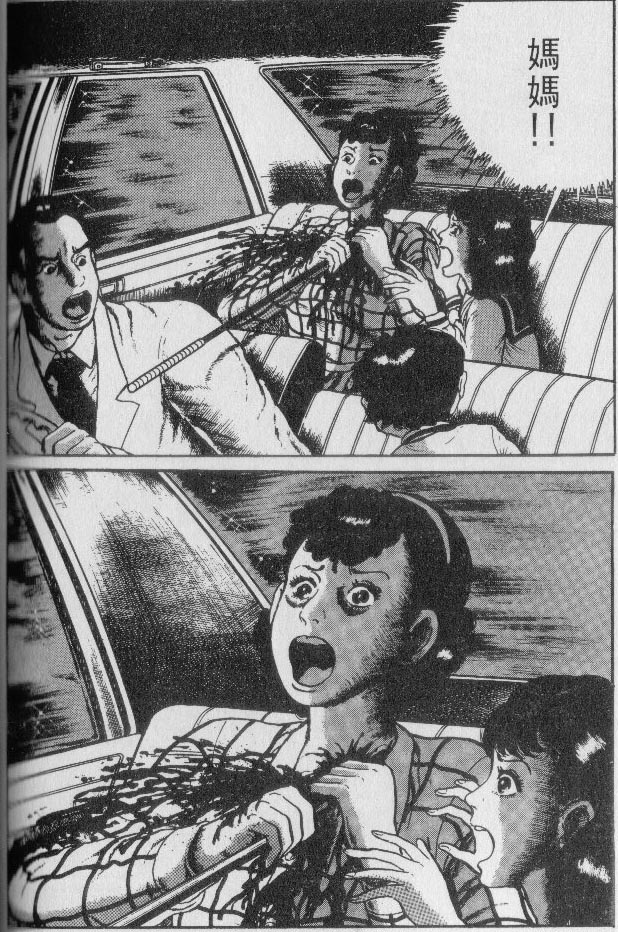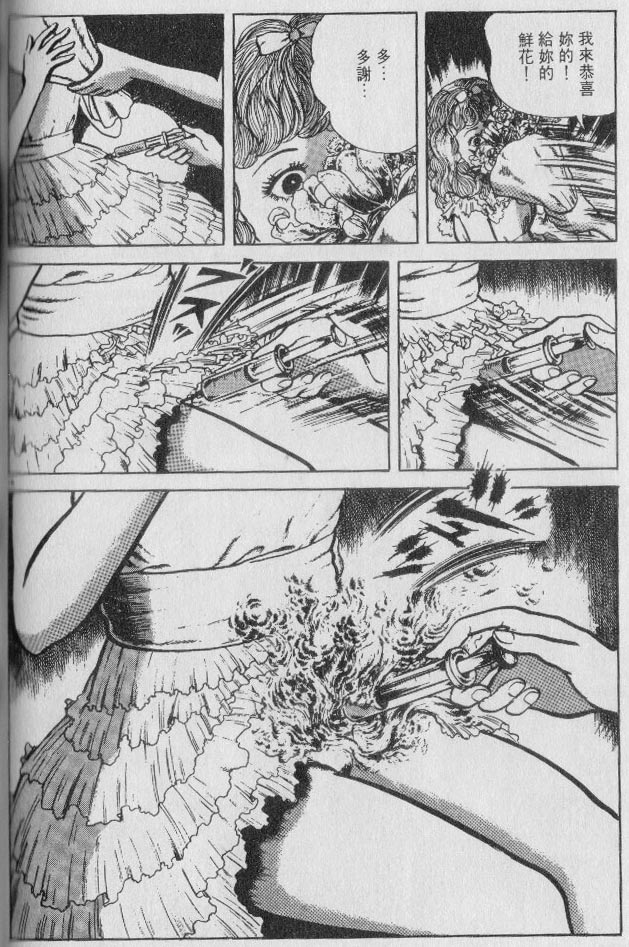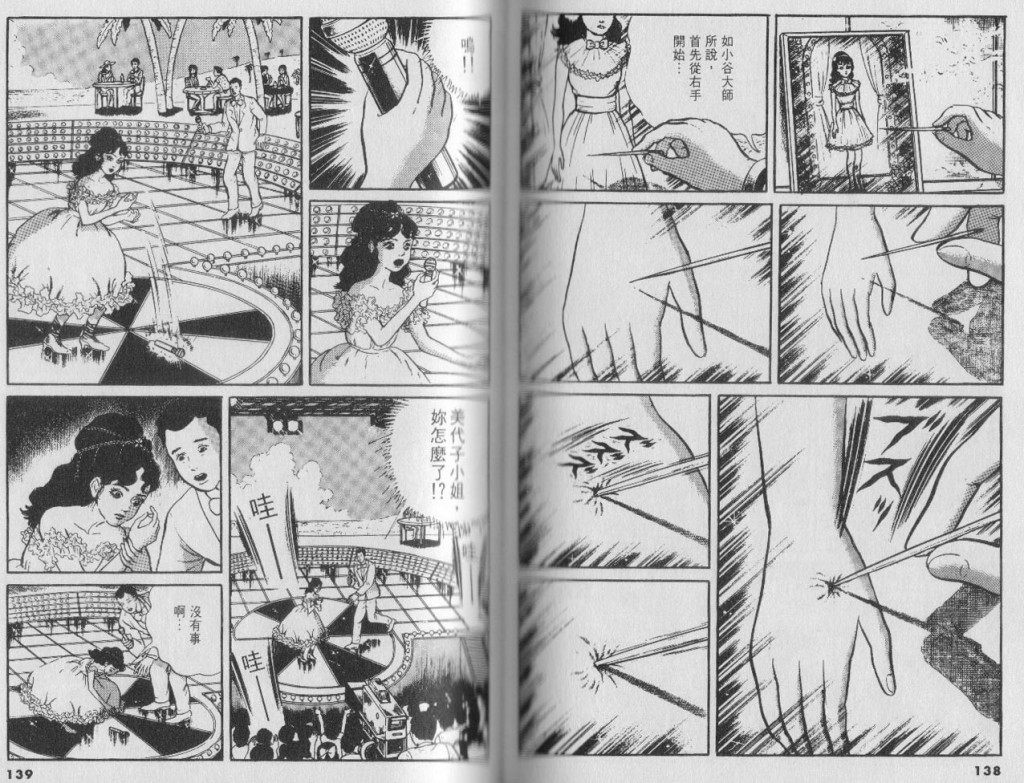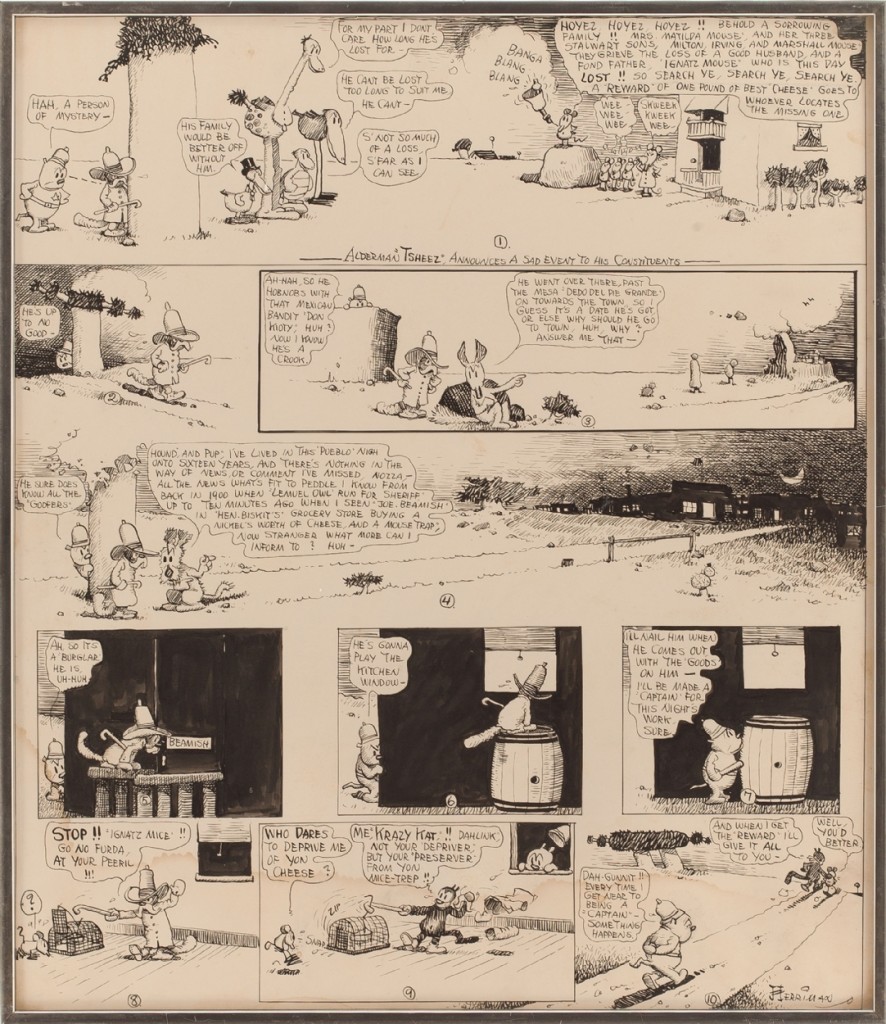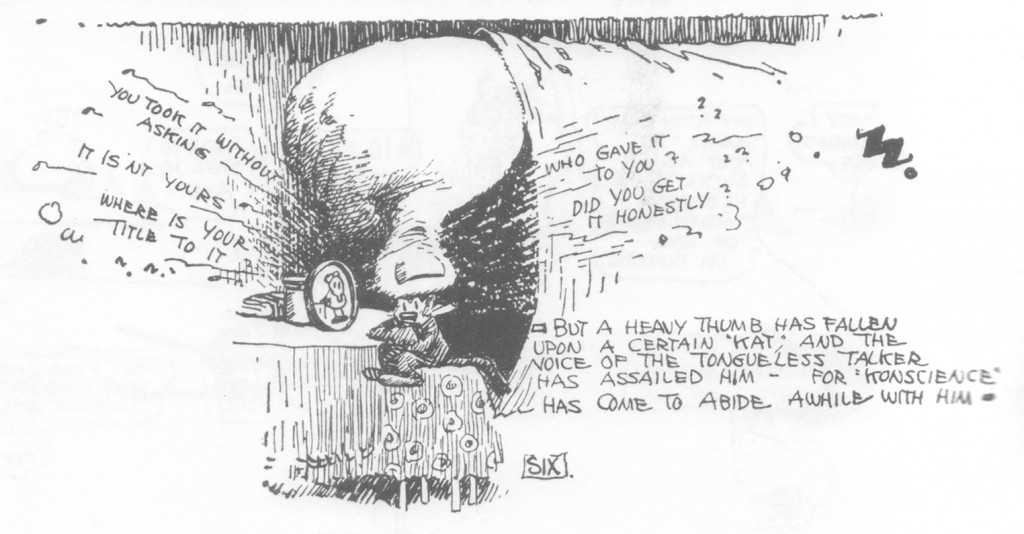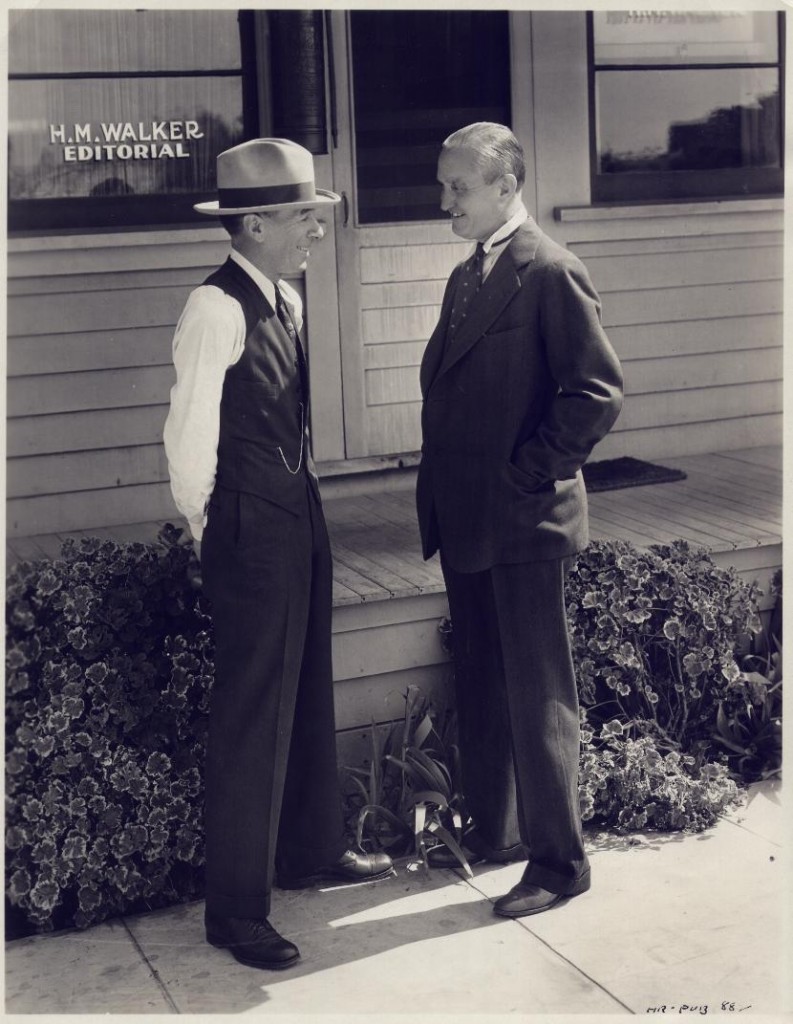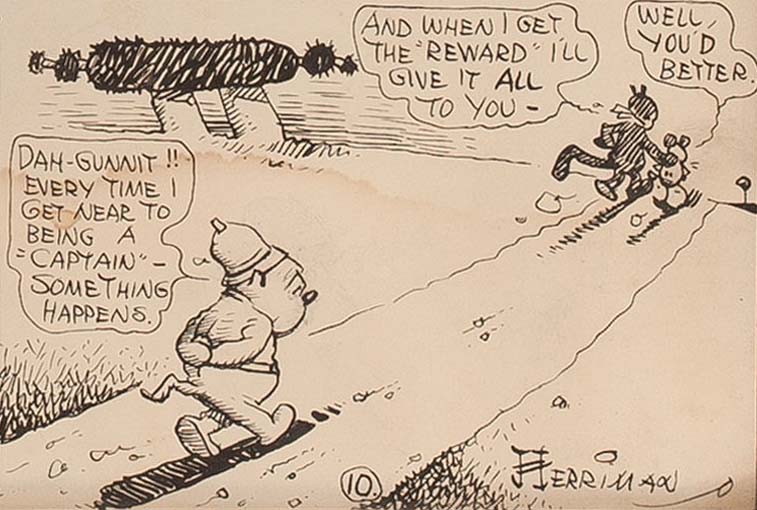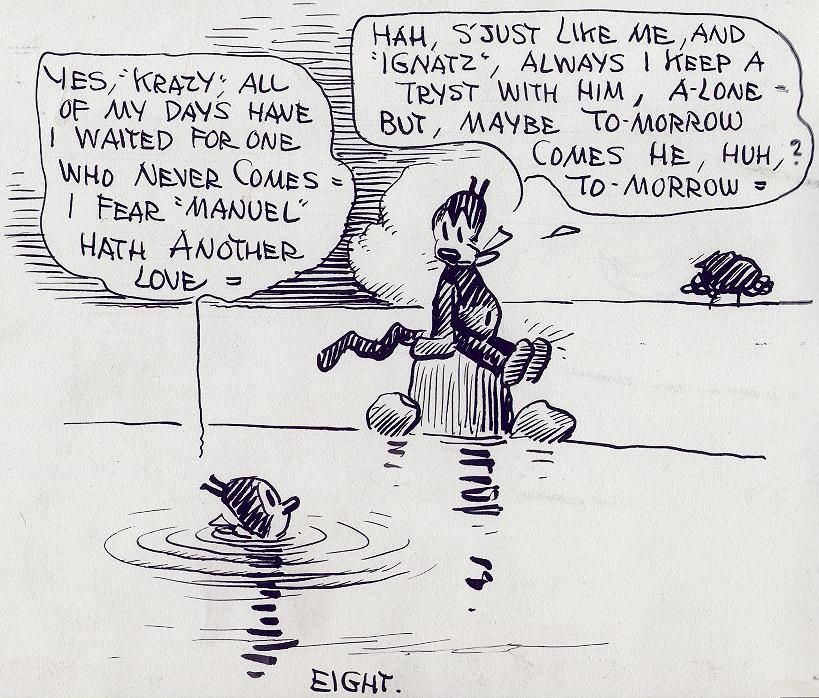A review of Anders Nilsen’s Big Questions. Limited edition signed and numbered hardcover, 7.25 x 9.25, colour, 658 pages.
Synopsis: A group of finches begin to consider the form of their sustenance and the structure of their lives; both of these governed by men who take on the stature of gods. One is a worldly, hallucinating fighter pilot delivering mystery in the form of a bomb — impatient, anhedonic, and destructive. The other is an “idiot” who takes what he can from nature; giving and removing life with the mercurial judgement of deity. An old and a new testament. The birds begin to take sides in keeping with their intellectual dispositions. The former figure attracts a complex theology, the latter, almost simple faith, trust, and finally devotion. There is a war of the gods and a hopeful denouement. The birds end up where they started, finally settling the big question they began with. Or have they…
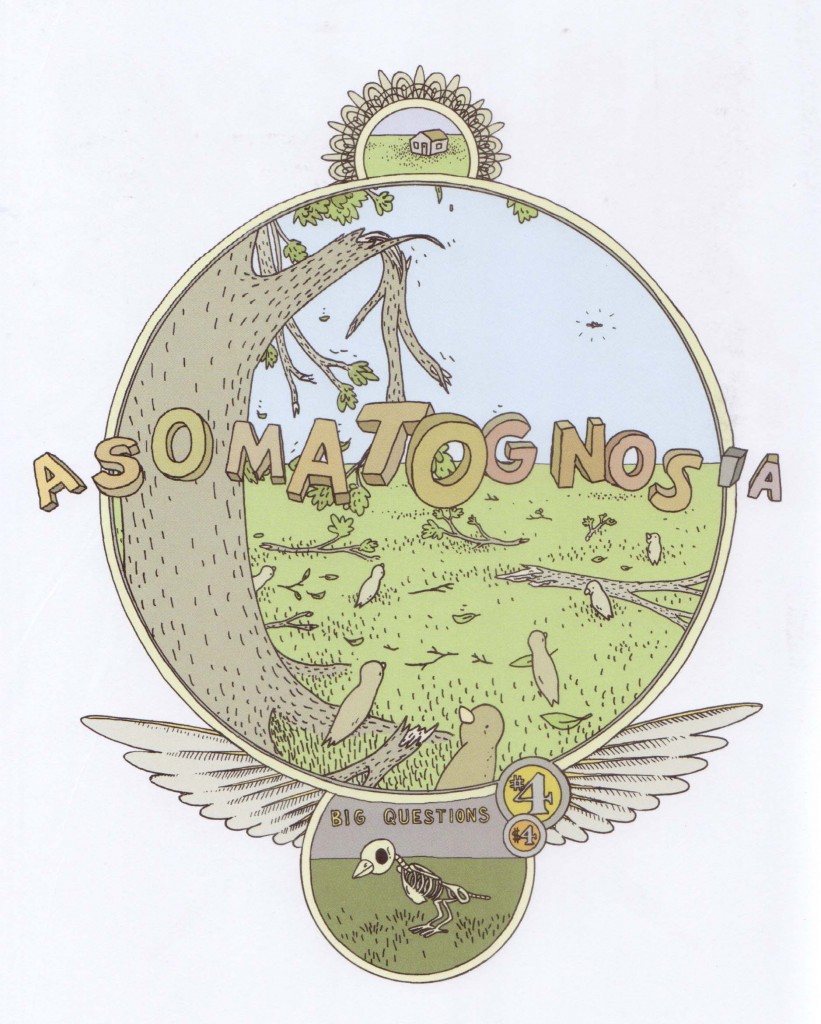
“Behold the fowls of the air: for they sow not, neither do they reap, nor gather into barns; yet your heavenly Father feedeth them. Are ye not much better than they?”
Matthew 6:26
Those looking for an encapsulation of the ingenuity and promise of the 90s small press — that calculated rawness, that sense of adventure, that palm-sized aesthetic object — could do worse than read Ron Rege Jr.’s Skibber Bee-Bye. Anders Nilsen’s collected Big Questions ,itself a product of the 90s, re-imagines this for the new millennium — that slow, hesitating shuffle away from Fort Thunder and its adherents into a world of hefty Smyth-sewn tomes heavy enough to kill a small animal. This world is more laid back, engineered, and formal; as thick and traditional in its narrative as Dash Shaw’s Bottomless Belly Button (a younger cousin of sorts), yet more sprightly and clever, and difficult to envision in any form except comics.
This new edition of Big Questions is easily digested in a single sitting and is the only sensible way to read Nilsen’s work. The individual issues suffer from a certain brevity and disconnect wrought through drawn out publication schedules, yet remain ultimately necessary for those interested in supporting independent comics artists and their publications. It is, perhaps, only in this collected edition that the inter-species relationships of Nilsen’s comic thicken and caramelize, only here that the pitched battles acquire any degree of emotional tension, only here that the scope of the entire work can be appreciated.
Nilsen describes the genesis of Big Questions some fourteen years ago in his afterword, recalling an artist’s workshop where a “very simple story…emerged [involving] a lost soldier in a barren landscape, a group of birds, and a plane crash”. He describes the process of learning how to draw comics over the course of this project, and that growth is clearly evident even within the first 100 pages of this collection. It is within these pages that we see ideas introduced and then discarded as they are found to be less useful (the somewhat clumsily drawn squirrels replaced by more vicious carrion eaters for instance); something we find not infrequently in comics which begin in a more freewheeling spirit before gaining concentration and more straightened purpose. Long dissertations give way to space and silence; static points of view are replaced by movement across panels and the use of the full expanse of the comics page; hesitating stippled backgrounds progress to detail and increasing complexity. All this mirroring Nilsen’s increasing confidence and conviction as a storyteller.
The “talking birds” come to Nilsen quite early and form the cornerstone of the early issues and chapters of Big Questions. The imagery seems at first to thrive on the curious irony of having birds consider impossible mysteries. The first of these (reiterated once again at the close of Nilsen’s comic) concerns nothing less than predestination and free-will.
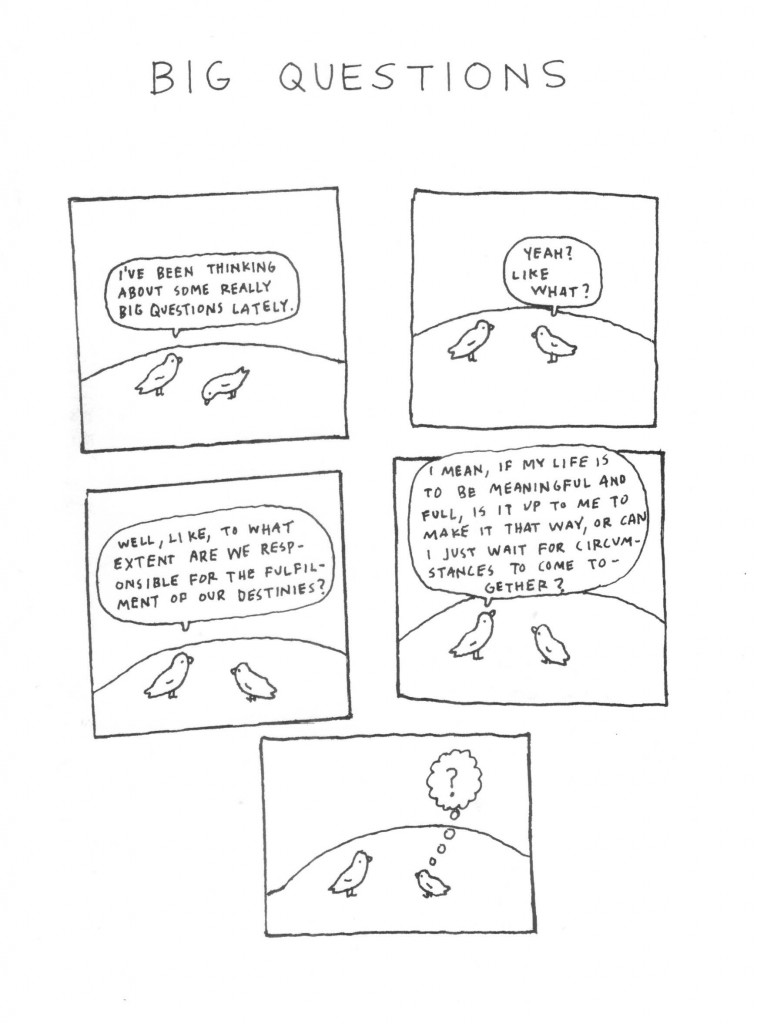
[The first big question]
Crystallized ideas and inquiries are pressed on the reader through this act of reduction. Our own wants are seen in the light of specks of indistinguishable food; our destinies seen more clearly and simply in the threads of fate that envelop the humble life of birds.
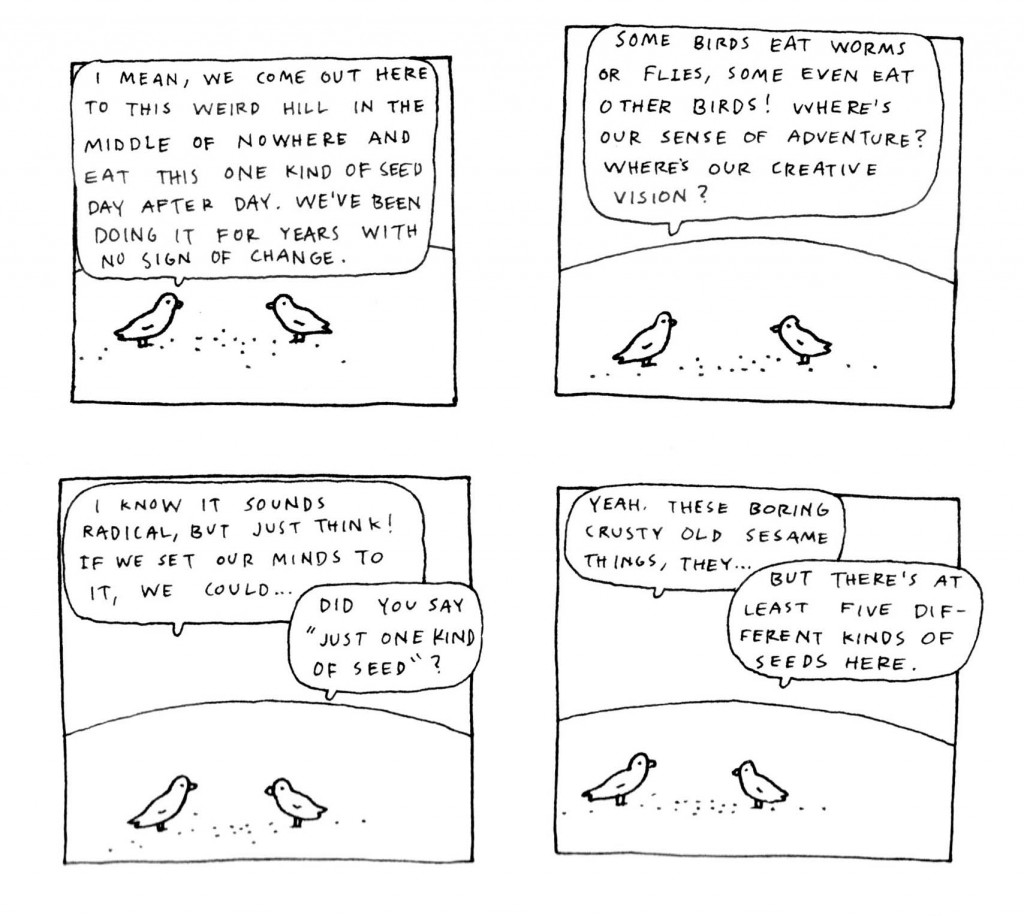
[Food and Life according to the birds]
Nilsen’s comic is a fable and parable asking us to reflect on where we are. The simplicity with which these ornithological forms and the distilled elements of their lives putting into sharp focus our own frailties and needs. The forms are delineated with a few strokes of Nilsen’s pen and brush but their direction, posture, and deployment suggest compassion, anger, and depression.
“I kind of like the idea that they are, in a way, all the same bird, just reacting to different situations and contexts. The sameness of the birds was an accident in a way, but ultimately I decided to embrace it as part of the book’s content.”
Anders Nilsen in an interview with James Romberger
These quickly drawn shapes almost never suggest the identity of the speaker. This can only be determined through deduction, dialogue and setting; a device which instills that sense of allegory which is itself reinforced by the author’s use of emblematic marks and legend. All this slowly coalescing into a grand narrative of interweaving lines — planned, symmetrical, and increasing in complexity — suggesting forms like a star of Bethlehem or the “Ley lines” and fractals which cut through nature; the meandering flight of birds; the by-ways of fortune.
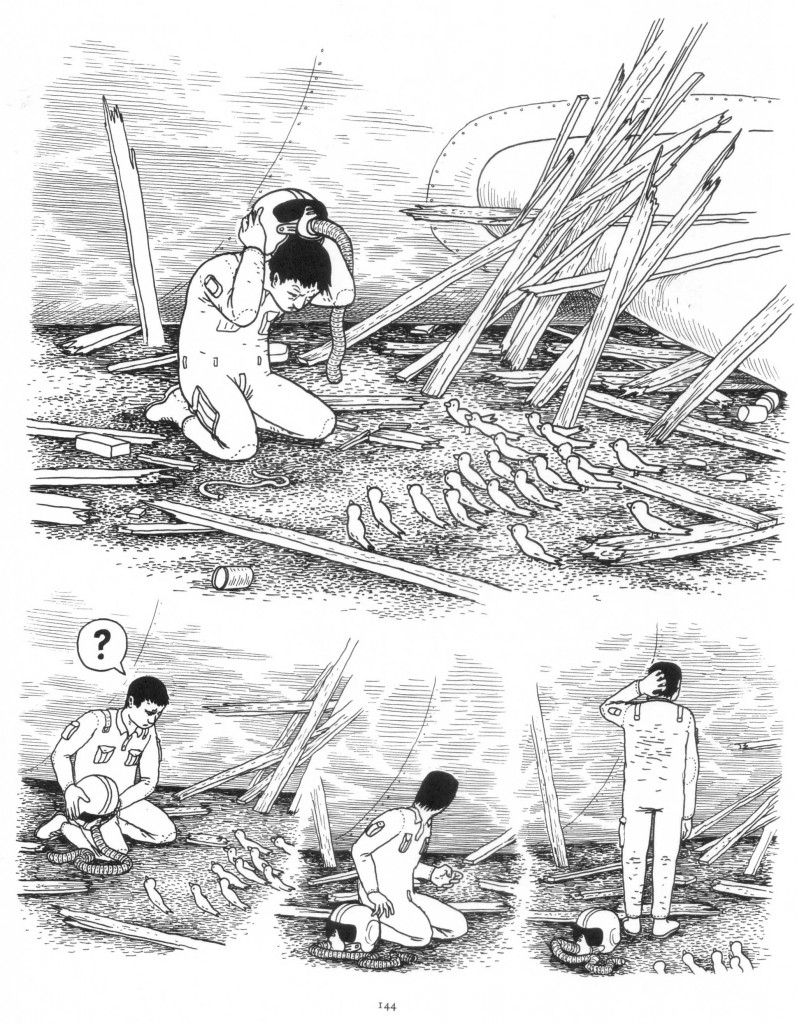
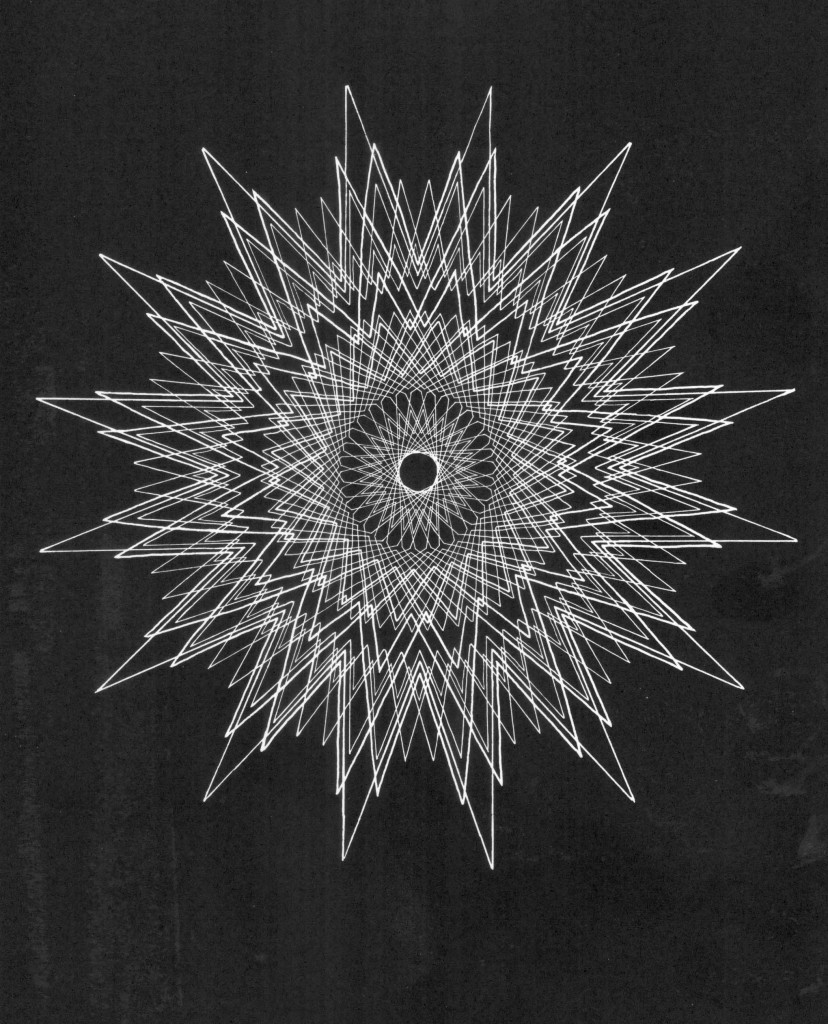
At one point, an airplane (a bomber) casts a dark shape over a pastoral landscape — an outsized shadow of the birds and hence ourselves.
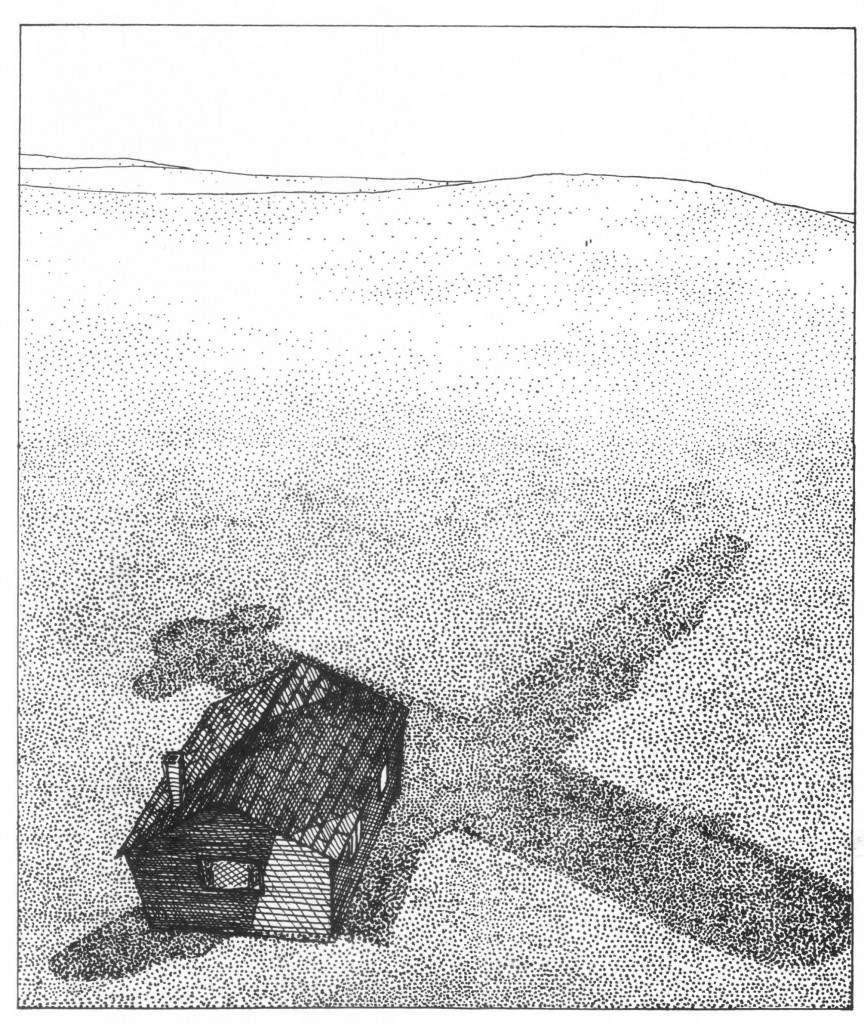
Much later we find a short journey into the underworld and Orphic myth.
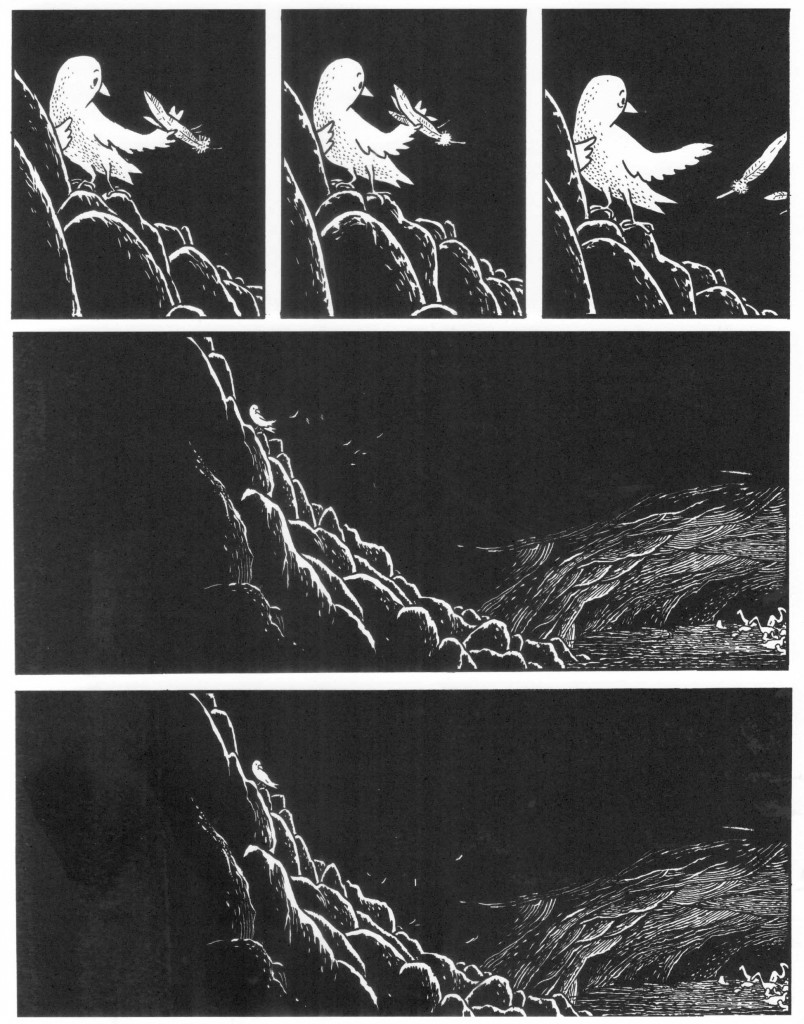
When Nilsen recalls the places and settings of his tale in the final pages of his work, we find both symbols and a microcosm: an Arcadian field; a fallen tree; a bomb crater containing the shadows and bones of the fallen scavenged by crows and wild dogs; a snake’s burrow guarding the entrance to the underworld; a river which is both the Jordan and the Styx; and life in cold relief.
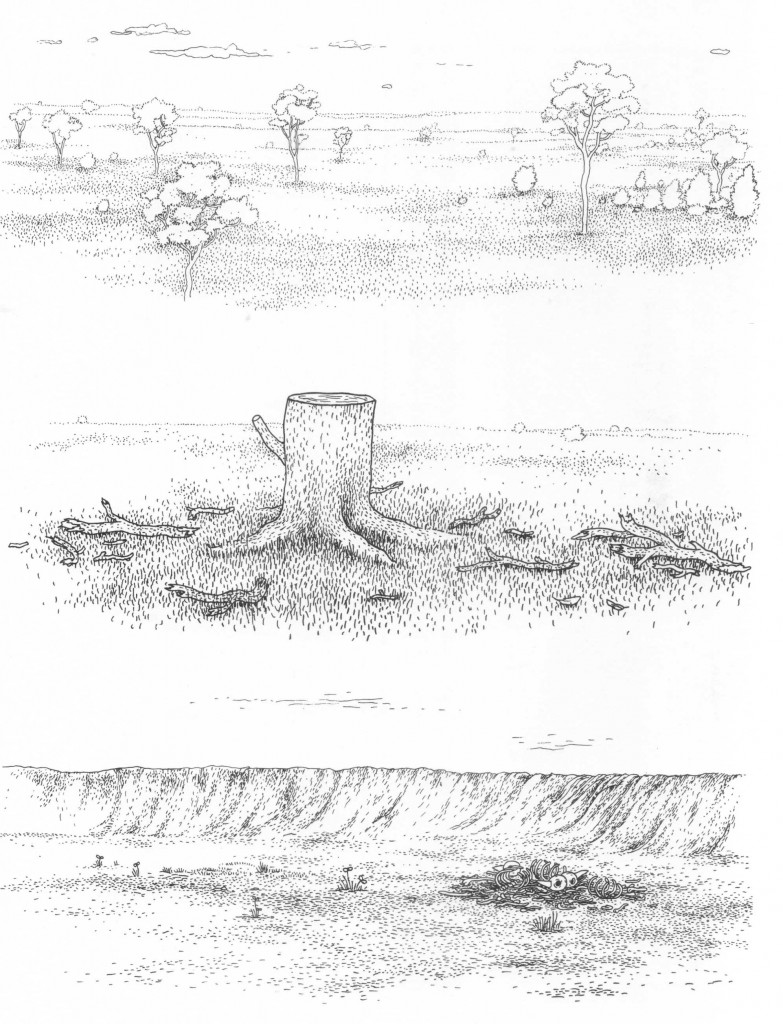

Religious themes punctuate the narrative consistently and continuously. The leader of a group of Messianic finches is called Zwingly (presumably after the reformer Zwingli), the proselytizing concerning the new religion is done by birds identified as evangelists. It is a mystery play with birds (Betty and Charlotte) standing in for the faithful-doubtful women kneeling at the foot of the cross or waiting faithfully at the empty tomb. There is an aged and kindly reptile guarding the gates to the underworld…
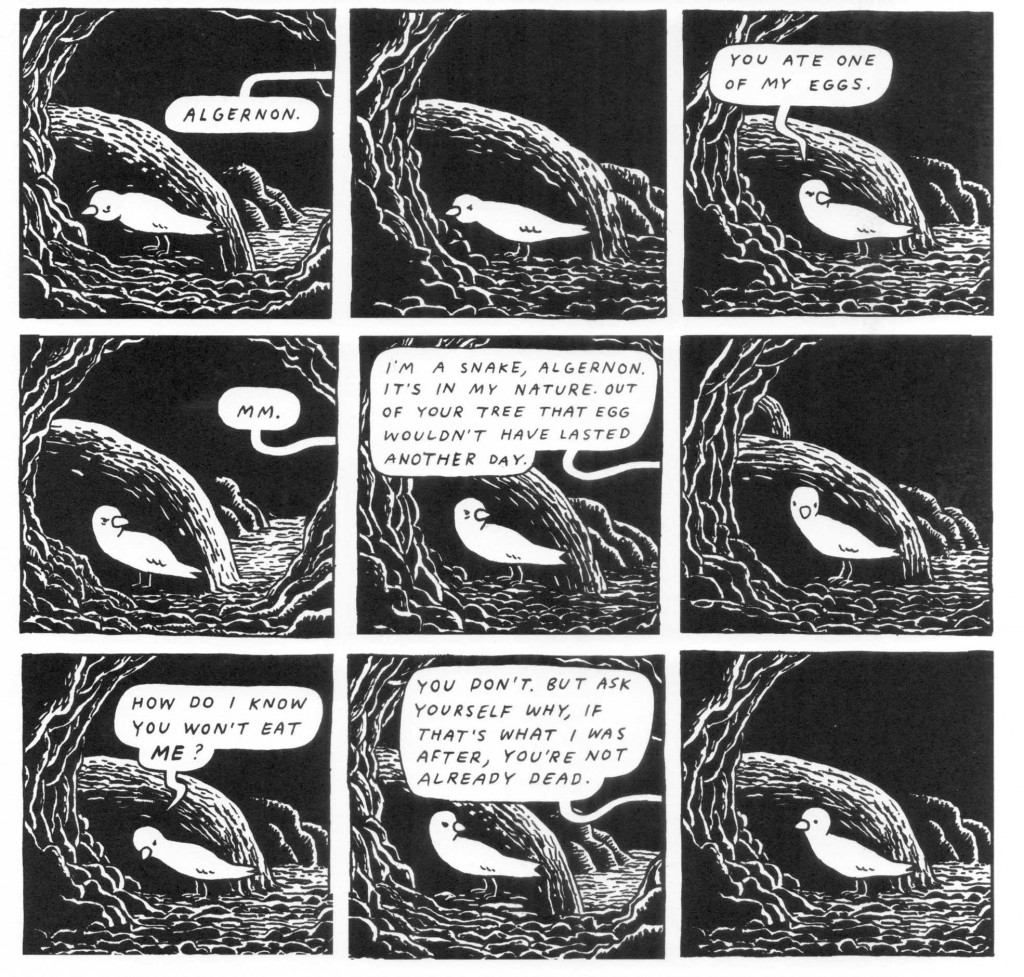
…and an erstwhile deity emerges like Wally Wood’s spaceman from the husk of a giant bird (a “miraculous visitation”) — a virgin birth; an Athena springing forth from the head of Zeus; a parthenogenetic celestial appearing before their eyes.

[“Jesus” by Wally Wood; “He Walked Among Us”]
A centerpiece of this exploration is the Lazarene miracle surrounding a finch called, Bayle. Raised from the dead even as he is killed by his faith — that ridiculous and dangerous longing to be held in the hand of an unknown force.

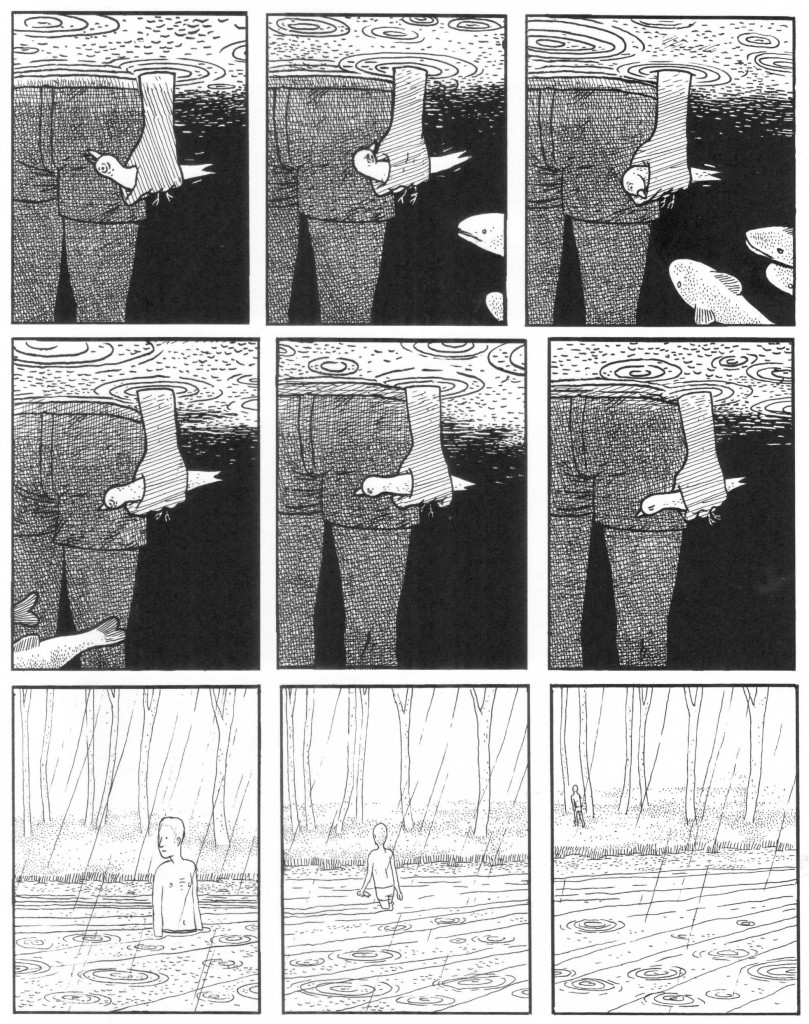
“It is a fearful thing to fall into the hands of the living God” (Hebrews 10:31).
There are other correspondences. The biblical narrative suggests that Jesus tarried for 2 days after receiving word of Lazarus’ illness (“This sickness will not end in death. No, it is for God’s glory so that God’s Son may be glorified through it.”) only then starting for Judea and Bethany. And so it is in Nilsen’s narrative, where death is almost an act of capriciousness and, more than this, devoid of compassion. Here, the author suggests that both life and death come from the same source, one so distant and unapproachable as to seem to emanate from an imbecile, monster, or saint.
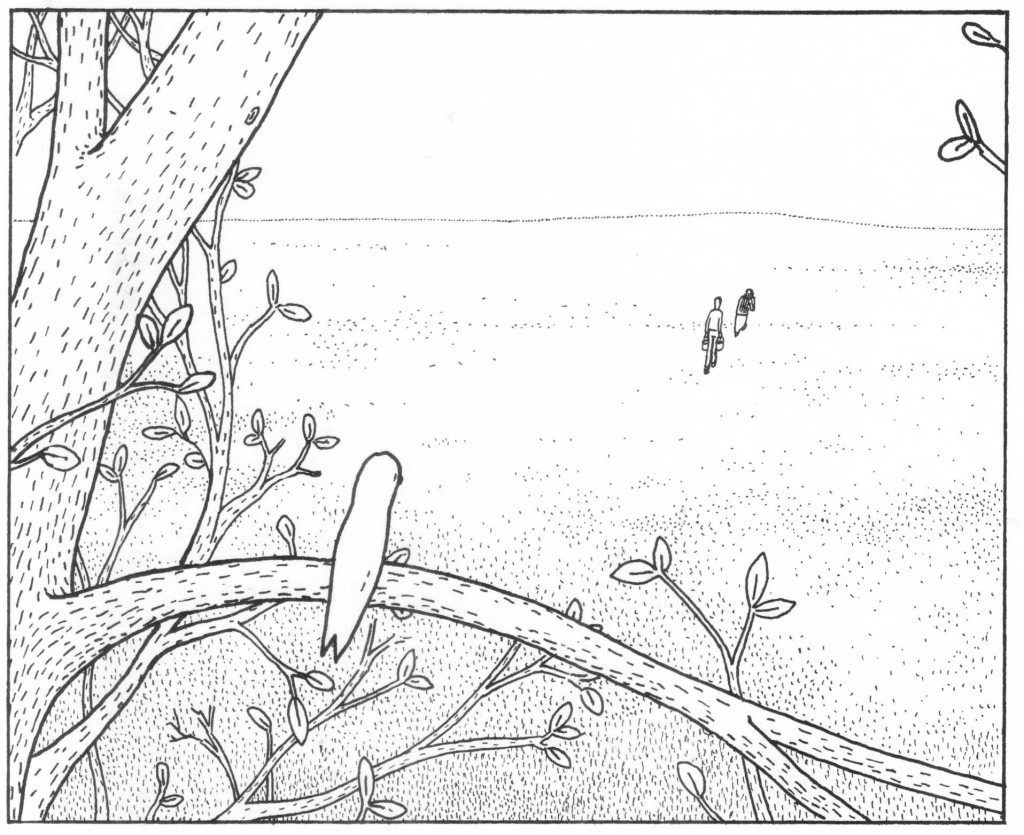
Nilsen’s standalone illustrations often depict wastelands, roadside accidents, and dumps. Disemboweled bodies centered in image and yet anonymous in their deaths; touched by some unseen pastel hand or angel; a vision of our fickle lives.
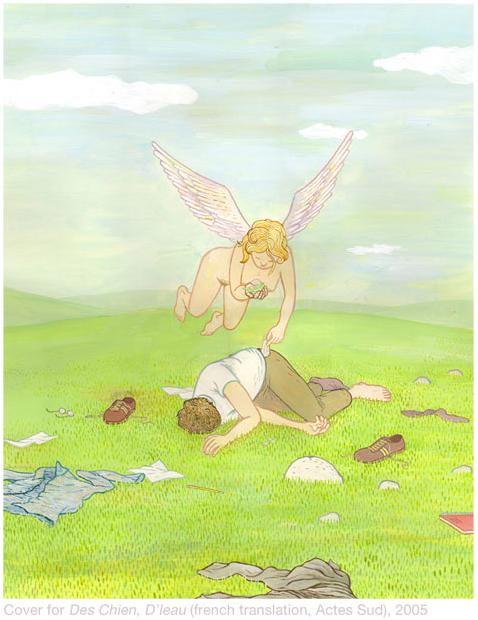
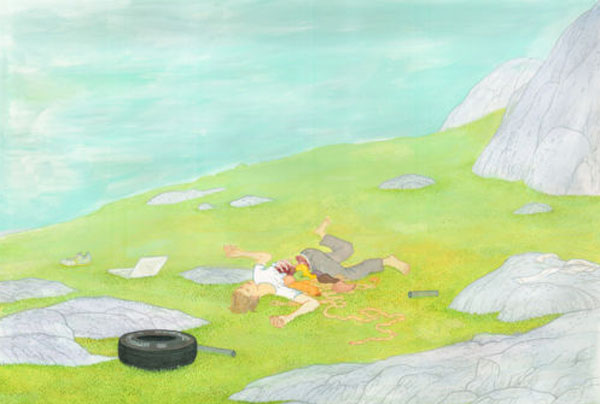
[Illustration work by Anders Nilsen]
Of course, Bayles’ death (a drowning) is made doubly significant for being a baptism from which he rises like the Holy Spirit above his messiah’s brow.
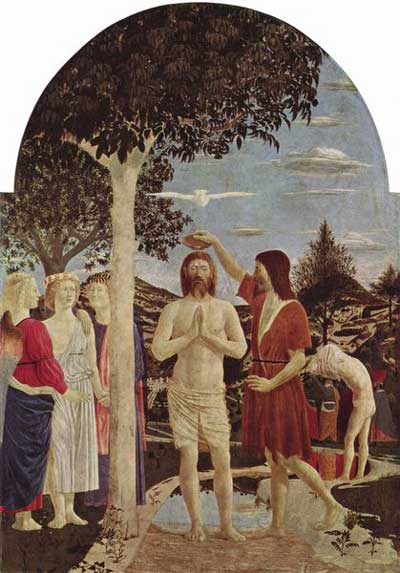
[Piero della Francesca’s Baptism of Christ]
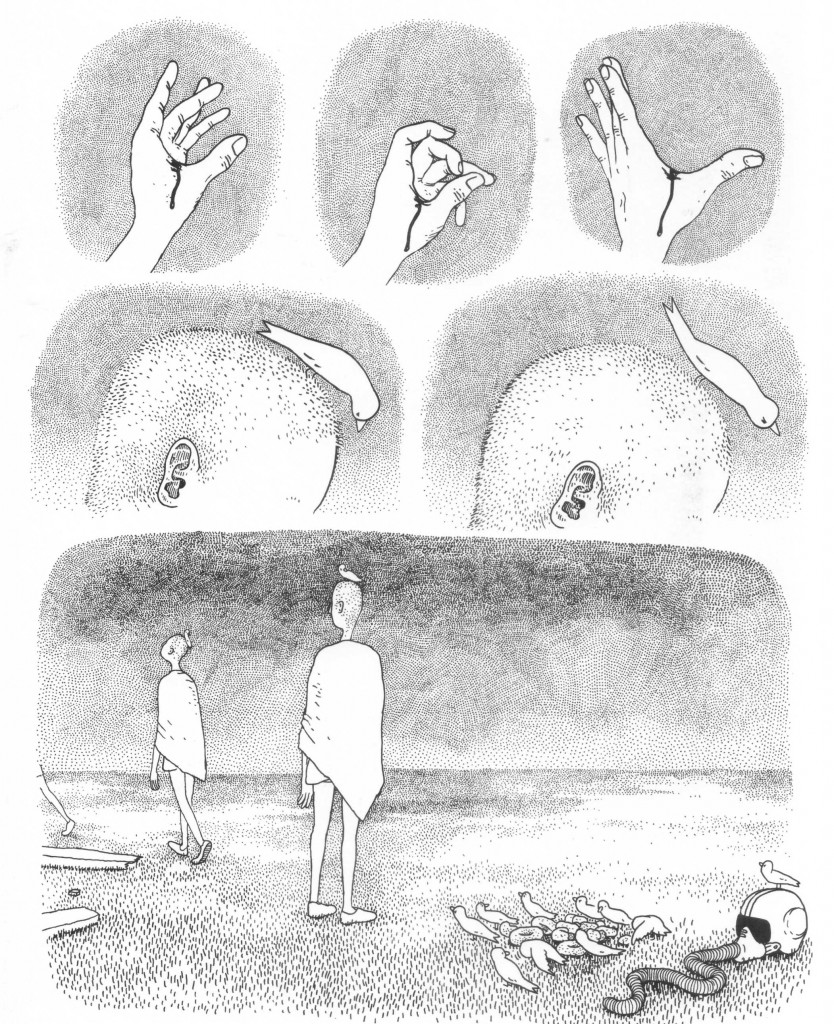
The ornitho-Christological theme is pressed to its limit: a feeding or, perhaps, a preaching to the birds by St. Francis occurs at one point; and a latter day Elijah is fed by the same winged beasts at journey’s end.

The doughnuts and crumbs upon which the finches feed become nothing less than the elements of the Eucharist, laced with the meat and blood of transubstantiation; a meal which is cursorily ridiculed as it has been through the ages.
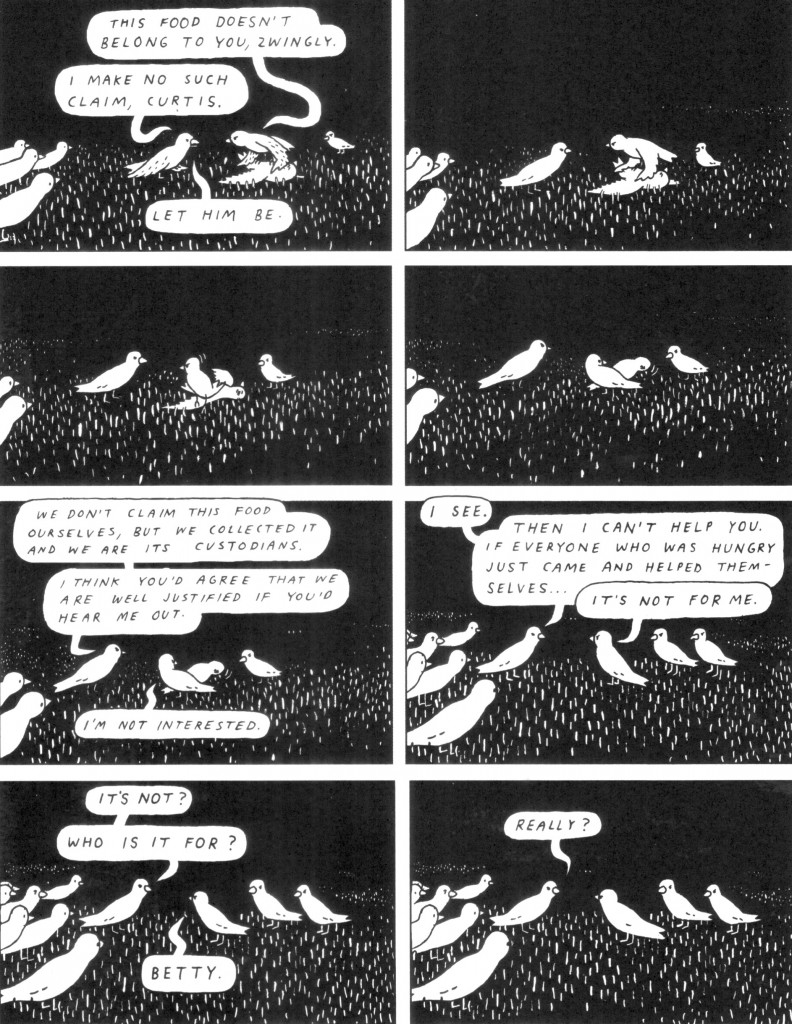
Like Eurydice and her pomegranate seeds, the bread is tainted not only by innocence but war and regret. “You are what you eat, little bird.” proclaims a carrion crow,
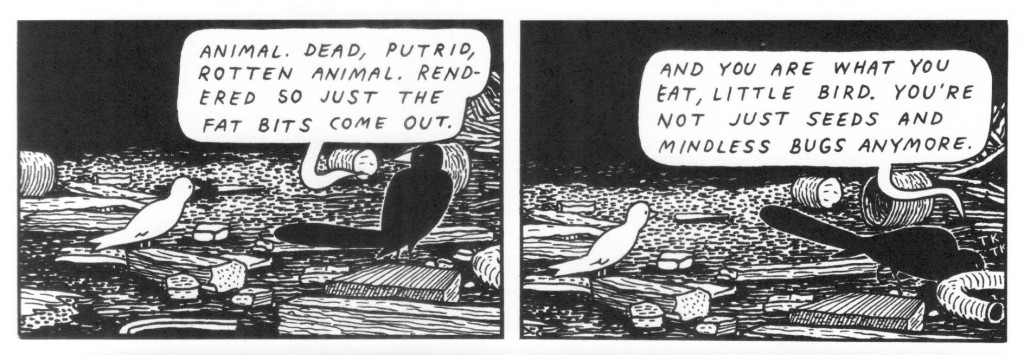
Nilsen never answers the big question he begins with, only jabbing lightly at the fabric of existence. If there is an answer in his puzzle and construct, it is the answer provided by the lives which writhe and weave before us in his tale; now seen from a factual and atheistic distance. A world governed by intention, coincidence, accidents, and foolishness. We can see some similarities with the work of Kevin Huizenga in that artist’s own “sermon notes” comics, philosophical inquires, scientific discursions, and theological musings.
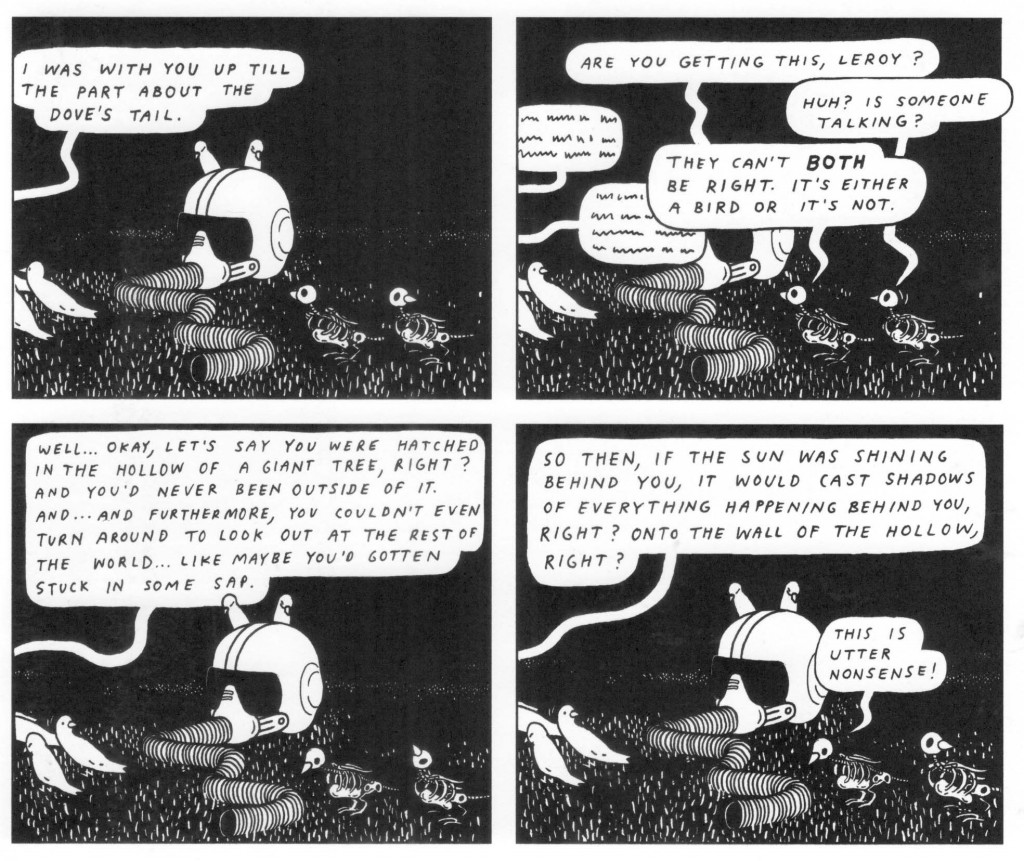
Plato’s Cave is for the birds
Neither is particularly dismissive but Nilsen is the true skeptic. He peppers his narrative with religious absurdities while occasionally leavening them with more kindly interpretation. His non-existent God is something which we feed and give life to, a concept which sometimes give us strength through blind chance and misplaced faith. As he states in his interview with Romberger:
“I think about that word, Asomatognosia, as a kind of metaphor for the religious impulse. I heard about the condition while listening to an interview with the neurologist Oliver Sacks. He described it as a condition where one loses one’s sense of ownership over a limb, usually an arm or hand…That sort of alienation from one’s own sense of control, our own agency, to me works as a kind of metaphor for the displacement of responsibility that a belief in the supernatural, or in god can sometimes entail. “
We can detect that appreciation for Sacks’ wry humor throughout this comic, not least in a skeletal evangelist reciting a Panglossian homily to a former friend.
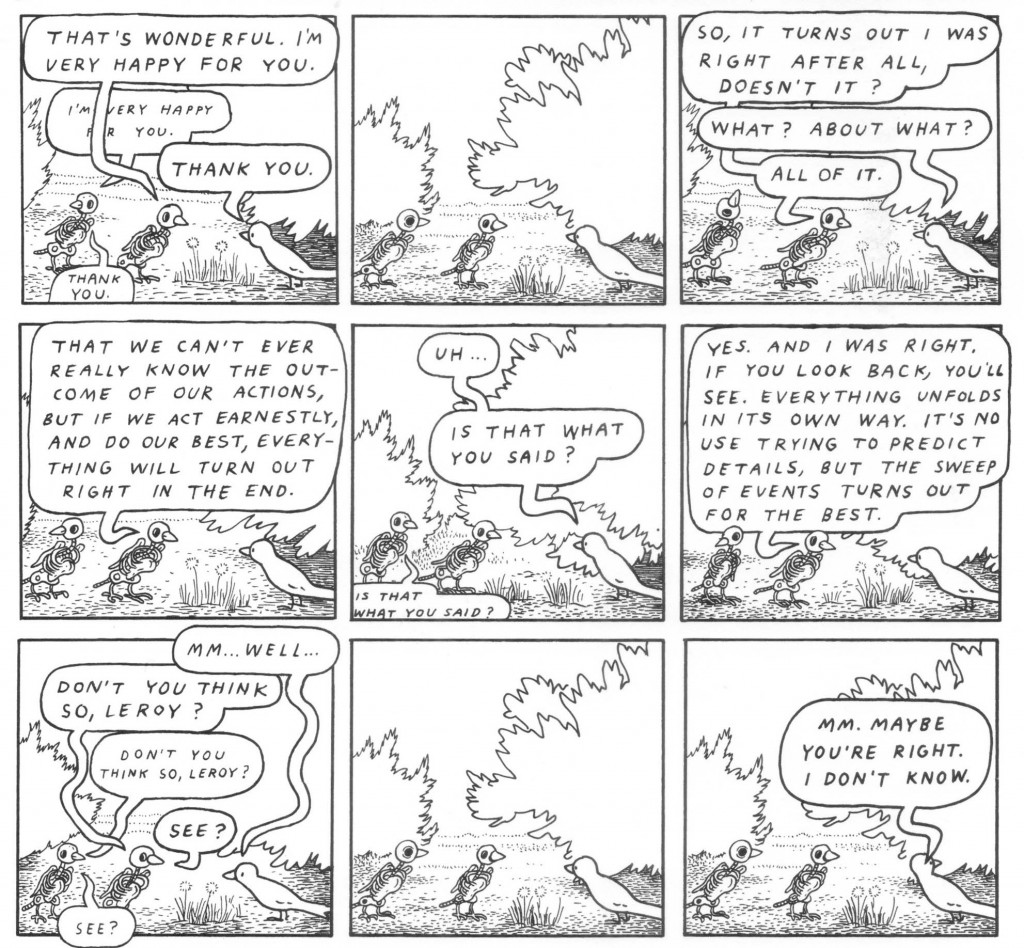
“Everything will turn out right in the end…”
…and the triumph of worldly “faith” and enlightenment.

The flower pots arranged and rearranged making us more keenly aware of their fragrance and color; the investigations and queries handled broadly rather than in depth; removing mystery from life. Nilsen would be the first to admit this and does so in his interview with Matthias Wivel at the metabunker:
“Nilsen: No, I haven’t read a lot of philosophy…I’m just curious about the world. Most of what I read is non-fiction; not philosophy explicitly, but I’ve always been interested in those kinds of issues, the heart of the matter…So I don’t think I approach these issues with a lot of knowledge about what philosophers who dealt with them before me thought about them, I don’t have a strong grasp of the history of them, but they’re just interesting questions and I’m learning. Also, my grandfather, my mother’s father, was a Lutheran minister of a very universalist stripe, so I think that some of the issues that I’m interested in are theological and stem from that…
Wivel: Are you religious?
I’m not religious at all, but I’m interested in thinking about religious issues, the nature of the world, meaning, things like that.”
If there is a problem with Nilsen’s comic, it would be this marginal interest — not so strange and wonderful to behold as the belief bordering on insanity we find in films like Andrei Tarkovsky’s The Sacrifice, and yet not so supremely intellectual in its contempt as to engage the reader’s mind fully. What remains is the emotional and aesthetic core of the narrative: the gradual mastery of form and narrative; the heat of battle; the sweetness of conversation; the pain of parting; and that sadness spoken through animals. And, perhaps, this is just enough to make us believe.
_____________________________________
Related articles
An interview with Matthew Baker at Nashville Review concerning his entire oeuvre.
An interview and introduction by James Romberger at Publishers Weekly. The initial discussion focuses on the spontaneity of the comics’ creation and its graphic design.
Matthias Wivel’s 2007 interview with the artist.
An interview at Comic Book Resources. “Using animals characters gives you a shorthand for personality and automatically connects them to some kind of symbolism. Birds are symbolic of transcendence or flight. Snakes have this history in Western culture, whether it’s the Garden of Eden or the way snakes are portrayed in Greek mythology. You get this extra material that just sits there in the background. You don’t have to be explicit about it but it can inform the story and inform the character.”
